Welcome to the essential guide for Identification and Natural History of the Ducks, Mergansers, Geese, and Swans of Florida. This resource features detailed accounts for 33 species, covering plumage, natural history, and calls, organized by taxonomic groups. We also include a dedicated section on urban, domestic, and feral ducks to help you confidently recognize any waterfowl found in the Sunshine State.
How to use this Guide
Click on any of the four major groups below (DABBLING DUCKS, DIVING DUCKS, GEESE, and SWANS) to explore the species included in each category, including their detailed subgroups. You can also use the Table of Contents below this section to browse the entire guide.
- How to use this Guide
- Birds Included in this Guide
- DABBLING DUCKS OF FLORIDA
- Core Dabbling Ducks (Anas/Spatula/Mareca)
- Blue-winged Teal (Spatula discors)
- Cinnamon Teal (Spatula cyanoptera)
- Northern Shoveler (Spatula clypeata)
- Gadwall (Mareca strepera)
- American Wigeon (Mareca americana)
- Eurasian Wigeon (Mareca penelope)
- Mallard (Anas platyrhynchos)
- American Black Duck (Anas rubripes)
- Mottled Duck (Anas fulvigula)
- Northern Pintail (Anas acuta)
- Green-winged Teal (Anas crecca)
- Black-bellied Whistling-Duck (Dendrocygna autumnalis)
- Fulvous Whistling-Duck (Dendrocygna bicolor)
- Wood Duck (Aix sponsa)
- DIVING DUCKS OF FLORIDA
- Core Florida Diving Ducks (Aythya)
- Canvasback (Aythya valisineria)
- Redhead (Aythya americana)
- Ring-necked Duck (Aythya collaris)
- Greater Scaup (Aythya marila)
- Lesser Scaup (Aythya affinis)
- Common Eider (Somateria mollissima)
- Surf Scoter (Melanitta perspicillata)
- White-winged Scoter (Melanitta deglandi)
- Black Scoter (Melanitta americana)
- Bufflehead (Bucephala albeola)
- Common Goldeneye (Bucephala clangula)
- Hooded Merganser (Lophodytes cucullatus)
- Red-breasted Merganser (Mergus serrator)
- Ruddy Duck (Oxyura jamaicensis)
- Masked Duck (Oxyura dominica)
- GEESE OF FLORIDA
- SWANS OF FLORIDA
- The Urban Mix: Feral and Domestic Waterfowl of Florida
- Florida Waterfowl Hotspots: Top 5 Locations for Viewing
- Threats and Conservation Status of Florida Waterfowl
Birds Included in this Guide
This guide features the ducks, mergansers, geese, and swans that occur in Florida. While most North American waterfowl species have been recorded here as vagrants or accidental visitors, this guide focuses on species whose official range includes the Sunshine State, as documented by the eBird/Science platform.
At the end, you’ll also find a section on domestic and feral species commonly seen in city parks and retention ponds. Because Florida’s wetlands are biodiverse, you will often find waterfowl sharing these habitats with other bird species. For a complete picture of the state’s avian life, you can explore our dedicated guide to Florida’s Herons, Egrets, and Bitterns, or browse our comprehensive overview of other Florida Wetland Birds, including storks, snipes, ibises, spoonbills, and rails.
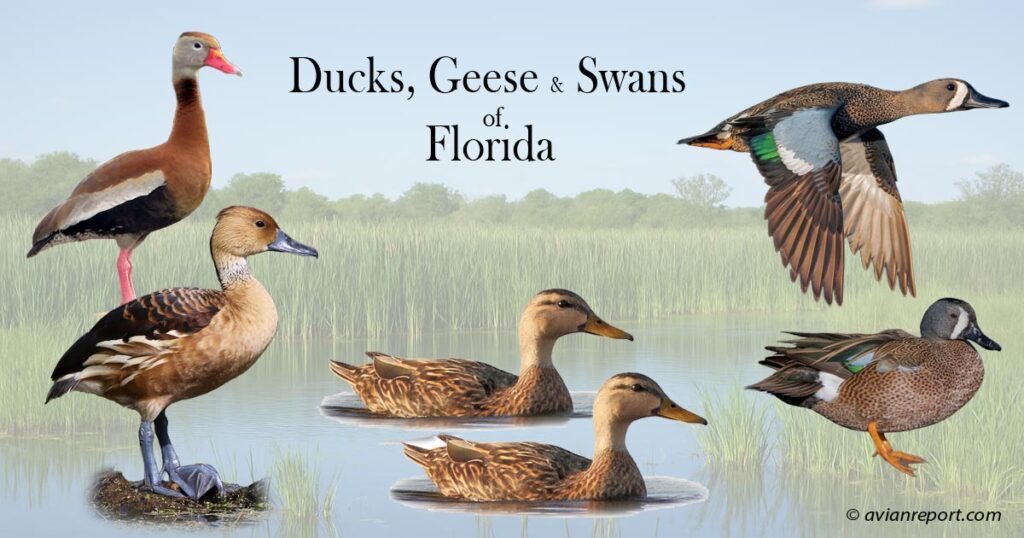
Beyond Florida Waterfowl: Exploring Essential Concepts and Definitions
This state-specific guide focuses on the local status and occurrence of waterfowl in Florida. However, to master key terminology and understand the science behind identification, you may wish to dig deeper into the foundational concepts. If you’re curious about topics like the “Big Divide” between Dabbling vs. Diving Ducks“, the function of their anatomy, how to identify plumage cycles, or the principles of migration and conservation across North America, these subjects are thoroughly explained in our comprehensive resource.
For an exhaustive breakdown of all definitions, concepts, and techniques used in this guide, please follow the link below to the main pillar page: Complete Guide to Ducks, Geese, and Swans of North America.
Species Included in this Guide
This guide includes a total of 32 species of ducks, mergansers, geese and swans. The breakdown by groups is as follows:
- Dabbling Ducks
- Core Dabbling Ducks: 11 Species.
- Whistling (Tree) ducks: 2 Species
- Specialized Dabbler Wood Duck: 1 Species
- Diving Ducks
- Core divers: 5 species.
- Sea ducks: 6 species.
- Mergansers (Sawbill Ducks): 2 species.
- Stiff-tailed duck: 2 species.
- Geese: 3 species.
- Swans: 1 species
DABBLING DUCKS OF FLORIDA
The Dabbling Ducks are the most commonly encountered waterfowl in the State, recognized by their habit of feeding in shallow water. They rarely fully submerge, instead feeding by tipping up to reach submerged plants and invertebrates—leaving only their tail feathers visible. Their legs are centrally placed, allowing them to walk easily on land and launch straight up into the air when taking flight.
Core Dabbling Ducks (Anas/Spatula/Mareca)
Blue-winged Teal (Spatula discors)
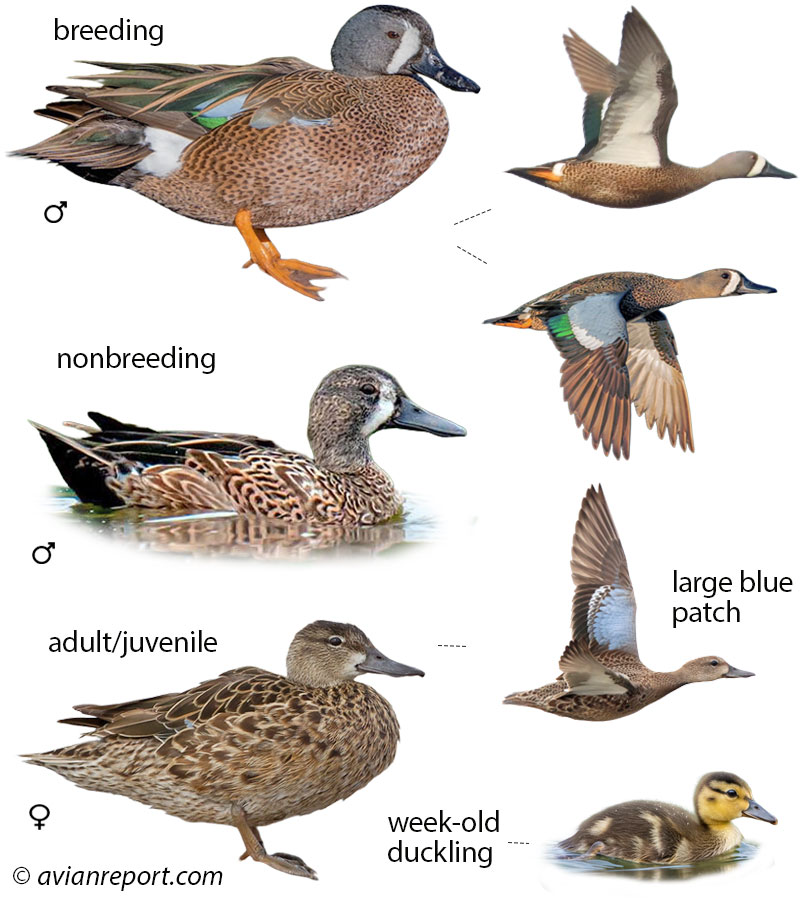
Length: 15 in, Weight: 14 oz, Wingspan: 24 in
Identification: Drake: slaty-blue head, white crescent behind bill, speckled brown body. Hen: brown, has a pale area at base of bill. Both sexes reveal bold powder-blue wing patches on the upper wing.
Compare: Hen Green-winged Teal is darker, and has a different wing color pattern. Hen Cinnamon Teal is warmer-toned overall, has a longer a more spatulated bill, and duller face pattern.
Behavior: Dabbling duck, tips up or submerges head/bill for food. Monogamous; pair bonds usually dissolve during incubation.
Flocking: The Blue-winged Teal forms small compact flocks that twist and turn at high speed. Flocks often fly low over marshes. It frequently mixes with other dabbling ducks.
Habitat: Shallow ponds, pond-marsh mixes, marshes, vegetated wetlands, rice fields, estuaries, mangroves.
Range: Breeds across much of North America; winters southern US to Central and South America.
Status and Movements: The Blue-winged Teal is a common winter resident and early migrant in Florida. Arriving in late summer, they depart by early spring, often seen in large flocks.
Diet: Aquatic insect larvae, crustaceans, clams, snails, and grains.
Nest: Small circular depression scraped by female. Lined with dried grasses and down/breast feathers.
Breeding: Egg laying: late Apr-Aug | Clutch: 6-14 eggs | Broods: 1 brood | Eggs: Creamy white | Incubation: 19-29 days.
Lifespan: At least 23 years, 3 months.
Population: Global breeding population estimated at 7.8 million individuals. The Blue-winged Teal is the second most abundant duck in North America.
Cinnamon Teal (Spatula cyanoptera)
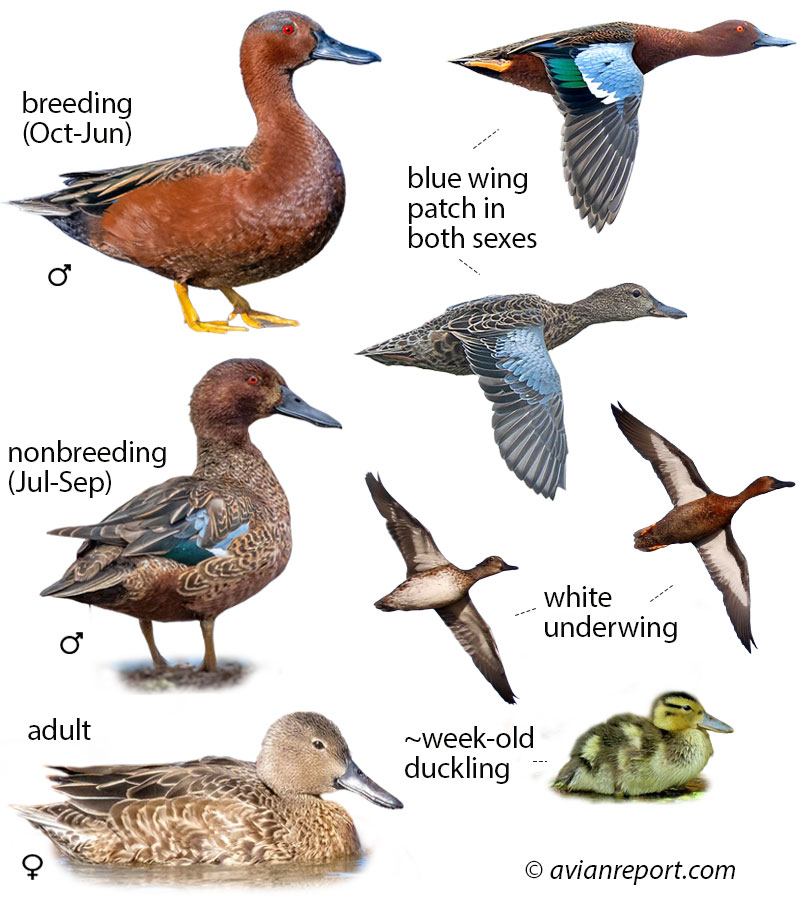
Length: 16 in, Weight: 13 oz, Wingspan: 22 in
Identification: Drake vivid rusty plumage, red eye. Hen/immature: rich brown overall. Both sexes have dark somewhat spatulated bill and large blue patches on the upper wing.
Compare: Hen Green-winged Teal is darker, and has a green wing speculum. Hen Blue-winged Teal is colder brown and has a pale area at the base of a shorter and narrower bill.
Behavior: Dabbling duck. Forages at water surface; tips up to strain seeds/insects with bill. Pairs form late winter/spring. Males guard mates until incubation.
Flocking: The Cinnamon Teal flies in pairs or very small flocks during the summer breeding season, and in small, highly maneuverable flocks during migration. It frequently associate with Blue-winged Teals and the Northern Shoveler into larger flocks.
Habitat: Freshwater wetlands, emergent vegetation, marshes, ponds, lakes, streams, reservoirs, wet agricultural fields, tidal estuaries, mangrove swamps.
Range: Breeds interior western North America. Winters Mexico.
Status and Movements: The Cinnamon Teal is a rare to accidental winter visitor in Florida. Occasionally observed from late fall through early spring, its presence is highly unpredictable.
Diet: Aquatic plant seeds, aquatic vegetation, zooplankton, insects, snails, beetles, midges, bulrush, smartweed.
Nest: Depression lined with rushes, grass, down. Often concealed below matted dead stems, approached via tunnels.
Breeding: Breeding Months: late Mar-mid-Sep | Clutch: 4-16 eggs | Broods: 1-2 broods | Eggs: Creamy white | Incubation: 21-25 days.
Lifespan: At least 10 years, 6 months.
Population: Global breeding population estimated at 380,000 individuals. The Cinnamon Teal is on the Yellow Watch List for declining populations.
Northern Shoveler (Spatula clypeata)

Length: 19 in, Weight: 22 oz, Wingspan: 30 in
Identification: Breeding Drake: Northern Shoveler has bright green head, white chest, rust sides. Hen/immature: mottled brown, large orange bill, blue wing patches. Unique shovel-shaped bill.
Compare: Drake and hen Northern Shoveler share their wing color pattern with Cinnamon and Blue-winged teals, but shovelers are noticeably larger. Hen has a large orangish and spatulated bill.
Behavior: Tips up and sweeps bill side to side to filter tiny prey. Large groups sometimes swim in circles to stir up food. Pairs stay together until almost fall migration.
Flocking: Flight is steady and direct typically in flocks of 5 to 20 birds during the non-breeding season. During the breeding season groups are generally limited to pairs. Northern Shovelers gather in larger rafts or flocks at major migratory stopovers.
Habitat: Shallow wetlands, coastal marshes, rice fields, flooded fields, lakes, sewage lagoons.
Range: Breeds across North America; winters southern U.S. south to Central America and Caribbean.
Status and Movements: The Northern Shoveler is a fairly common winter resident in Florida, arriving in late fall. This unique dabbling duck is typically present through winter, departing by early spring, usually by March.
Diet: Tiny crustaceans, aquatic invertebrates, seeds.
Nest: Small depression on ground. Lined with downy feathers. Surrounded by vegetation, typically within 150 feet of water.
Breeding: Egg laying: May-Jun | Clutch: 8-12 eggs | Broods: 1 brood | Eggs: Pale greenish gray or olive-buff | Incubation: 22-25 days.
Lifespan: At least 16 years, 7 months.
Population: Global breeding population estimated approx. 5.9 million individuals.
Gadwall (Mareca strepera)
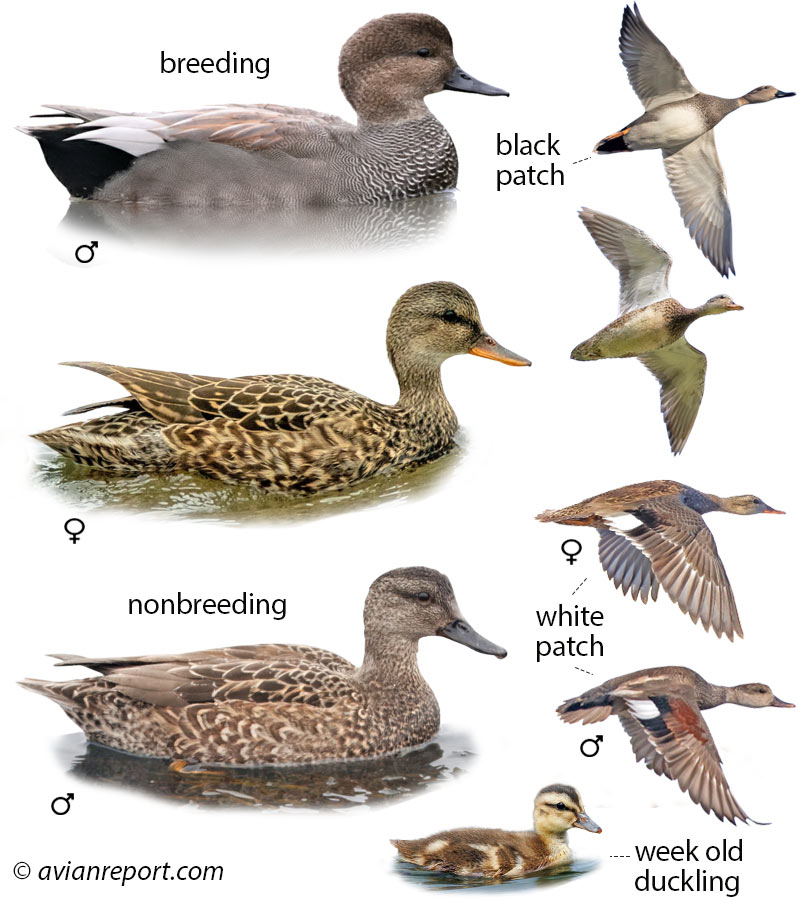
Length: 20.1 in, Weight: 31 oz, Wingspan: 33.1 in
Identification: Drake intricate gray-brown pattern, black rear end. Hen patterned brown/buff, thinner dark bill with thin orange edge. Both sexes show a white wing patch.
Compare: Hen Gadwall is similar to other female teals but has an orange line along the edge of the bill. Both sexes have a distinctive white wing patch. Hen Mallard has a large blue wing speculum.
Behavior: Tips forward for submerged vegetation, rarely dives. Pairs form early, often in late fall. Seasonally monogamous.
Flocking: The Gadwall flies swiftly in a small to medium size flocks, often in a nervous, irregular fashion with many twists and turns.
Habitat: Prairie potholes, Canadian prairies, tundra, boreal forest wetlands, fresh/salt water wetlands.
Range: The Gadwall breeds primarily in the Great Plains and Canadian prairies; winters across the southern U.S. and Mexico.
Status and Movements: The Gadwall is a common winter resident throughout Florida‘s wetlands. They typically arrive by October and remain until March or April, preceding their northward migration.
Diet: Mostly submerged aquatic vegetation, snails, midges, water beetles.
Nest: Hollow scrape on ground, lined with twigs, leaves, down.
Breeding: Egg laying: mid-Apr-Jun | Clutch: 7-12 eggs | Broods: 1 brood | Eggs: N/A | Incubation: 24-27 days
Lifespan: At least 19 years, 6 months.
Population: Approximately 4.4 million individuals.
American Wigeon (Mareca americana)

Length: 20 in, Weight: 33 oz, Wingspan: 33 in
Identification: Drake: gray head with a white forehead and crown, green patch behind the eye, cinnamon body, large white wing patch. Bill: pale gray, black tip, white rump. Hen: plainer brown with rusty sides.
Compare: Drake American Wigeon differ from drake Eurasian Wigeon due to a chestnut head and a buffy forehead. Hen Eurasian has a warmer orangey head, but difficult to separate from hen American.
Behavior: Forages on the surface or tips up for aquatic plants; plucks terrestrial plants with short bill. Quite vocal; distinctive whistle.
Flocking: The American Wigeon is highly social outside of breeding season, forming large noisy flocks on water and grazing fields.
Habitat: Freshwater wetlands, lakes, slow rivers, marshes, estuaries, bays, grasslands, pastures, golf courses.
Range: Breeds Alaska, Canada, Northwest U.S.; winters southern U.S. and Mexico.
Status and Movements: The American Wigeon is a common winter resident across Florida. Look for these distinctive dabblers from late fall through early spring, as they typically depart the state by April.
Diet: Aquatic plants. Upland plants. Invertebrates (midges, mollusks).
Nest: Small depression on dry ground, sometimes far from water. Lined with grasses, reeds, cattails, and down feathers.
Breeding: Egg laying: Early May-Jun | Clutch: 3-13 eggs | Broods: 1 brood | Eggs: Creamy white | Incubation: 22-28 days.
Lifespan: At least 21 years, 4 months.
Population: Approximately 2.7 million individuals.
Eurasian Wigeon (Mareca penelope)
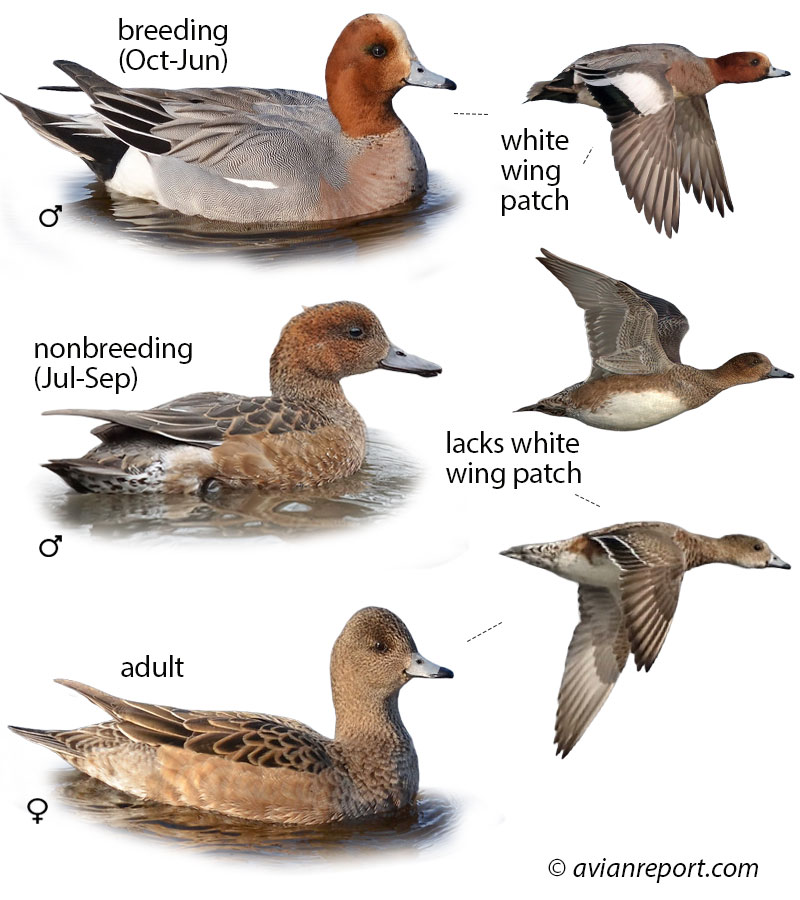
Identification: Drake: gray body, bright rufous head, buffy-cream forecrown, large white wing patch. Hen: mostly brown, some rufous on flanks/head. Juveniles resemble females. Bill: black-tipped, blue-gray.
Compare: Drake is similar to a drake American Wigeon, which has a gray head and white forehead and crown. Hen American has a colder gray head.
Behavior: Forages in flocks, tips up for submerged plants. Males court with ritual movements, often gathered around one female.
Flocking: The Eurasian Wigeon is highly gregarious outside of breeding season. In North America, they are almost invariably found mixed within large flocks of American Wigeon.
Habitat: Shallow wetlands, freshwater marshes, ponds, lakes. Winters: coastal sites, estuaries, bays, brackish lagoons.
Range: Rare visitor to North America. Winters Pacific/Atlantic coasts (Iceland/Asia origin).
Status and Movements: The Eurasian Wigeon is a rare winter visitor to Florida, sometimes observed from late fall to early spring.
Diet: Aquatic/terrestrial plants. Grasses, cultivated rice, wheat, barley, potato. Invertebrates.
Nest: Shallow depression on ground. Near small pond/marsh or upland site. Lined with grasses and female breasts down.
Breeding: Does not breed in NA | Clutch: 6-12 eggs | Eggs: Buffy in color | Incubation: 22-28 days.
Lifespan: At least 33 years, 7 months (Europe).
Population: Worldwide breeding population estimated at 2 million individuals.
Mallard (Anas platyrhynchos)
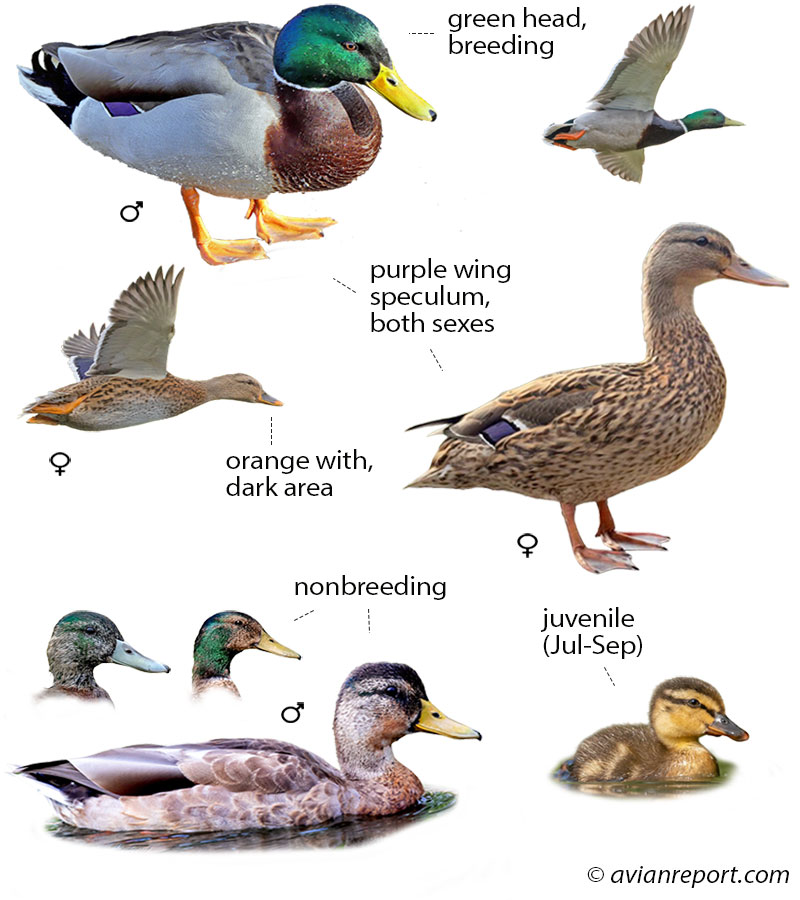
Length: 23 in, Weight: 41 oz, Wingspan: 35 in
Identification: Drake: iridescent green head, yellow bill, gray flanks, pale tail with black tail-curls. Hen/Juvenile: mottled brown, orange bill with dark patch. Both sexes show white-bordered, blue speculum.
Compare: The hen Mallard differs from hens American Black Duck, Mottled Duck, and Mexican Duck due to a warmer brown body, black and orange bill, and bold white wing bars on the leading and trailing edges of the blue wing speculum.
Behavior: Dabbling duck, tips forward to graze; rarely dives. Generally monogamous, pairs form in fall.
Flocking: Mallards are social and gregarious outside of breeding season. They form large, loose flocks (up to hundreds of birds) often mixing with other dabblers.
Habitat: Ponds, lakes, marshes, rivers, coastal habitats, estuaries and City parks.
Range: Widespread throughout North. Breeds far north; year-round/winter in central/southern U.S. and Mexico.
Status and Movements: The Mallard is an uncommon winter resident in Florida, arriving in fall and departing by spring. While some feral populations persist, wild birds are typically only present during cooler months.
Diet: Seeds, aquatic vegetation, insect larvae, freshwater shrimp. Agricultural grain, human handouts.
Nest: Shallow bowl/depression on ground near water, concealed under vegetation.
Breeding: Egg laying: Early-Apr-Jul | Clutch: 1-13 eggs | Broods: 1-2 | Eggs: Creamy to grayish or greenish buff | Incubation: 23-30 days.
Lifespan: At least 27 years, 7 months.
Population: Estimated population around 19 million individuals.
American Black Duck (Anas rubripes)

Length: 22 in, Weight: 42 oz, Wingspan: 36 in
Identification: Dark brown body, pale gray-brown head. Drake: yellow-green bill. Hen: duller olive bill. Both show iridescent purple speculum; white underwings visible in flight.
Compare: Similar to a hen Mallard, which has a lighter warmer brown body, orange and black bill, and bold white wing bars on the leading and trailing edges of the blue wing speculum.
Behavior: Tips up for food; rarely dives. Monogamous pairs. A wary duck.
Flocking: The American Black Duck is moderately social, usually forming small, loose flocks or pairs that often mix with Mallards. Flocks fly swiftly in direct lines or small, tight groups. Rarely forms the large rafts.
Habitat: Freshwater wetlands, saltmarshes, beaver ponds, bogs, wooded swamps.
Range: Eastern North America; breeds Canada/Northeast U.S.; year-round/winter throughout Eastern U.S.
Status and Movements: The American Black Duck is an uncommon winter resident in Florida. These wary dabblers arrive in late fall and remain through winter, typically departing the state by early spring.
Diet: Plant matter, seeds, roots, tubers, leaves, aquatic insect larvae, crustaceans, agricultural grains.
Nest: Shallow bowl/basin on ground, well-concealed under vegetation near water. Lined with grass and down feathers.
Breeding: Egg laying: late Mar-early Aug | Clutch: 6-14 eggs | Broods: 1 | Eggs: White, cream-colored, pale greenish buff | Incubation: 23-33 days.
Lifespan: At least 26 years, 5 months.
Population: Global breeding population estimated at 700,000 individuals.
Mottled Duck (Anas fulvigula)
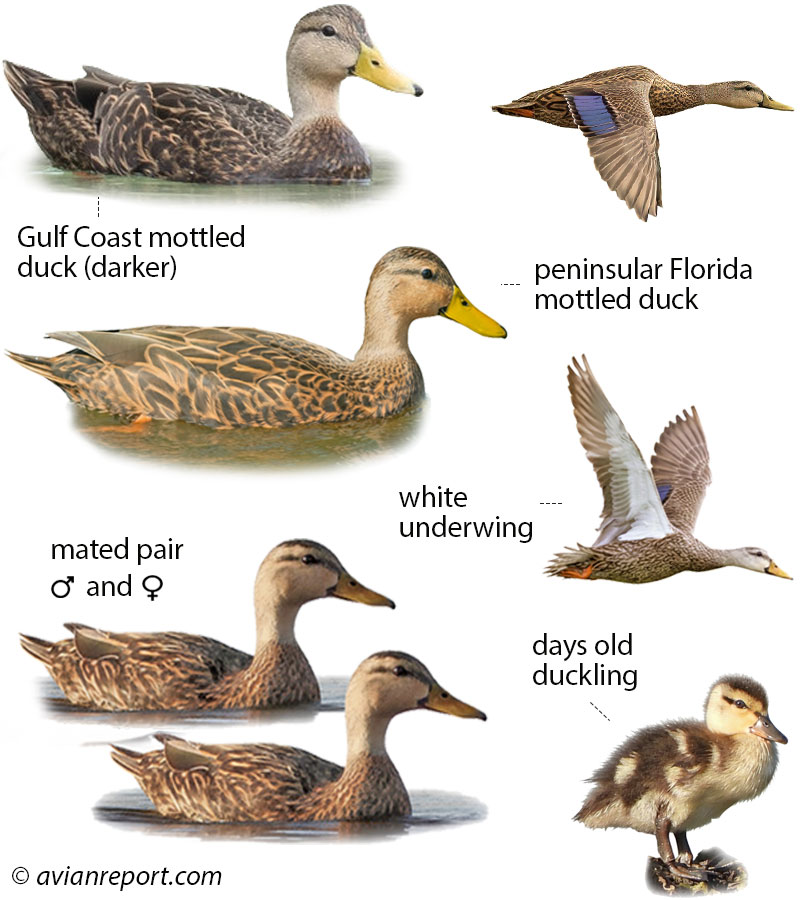
Length: 20.5 in, Weight: 36 oz, Wingspan: 32 in
Identification: Rich brown/buff body, buffy head/neck. Mottled Duck drakes: yellow bill. Hens: greenish yellow bill, variable dark markings. Black spot at gape. Pure Mottled Duck tail is dark.
Compare: Similar to a hen Mallard, but has a creamy head, plain yellow-olive bill and very thin leading and trailing white wing bars on the speculum. Female Mallards have whitish tail feathers. Hybrids can be confusing.
Behavior: Forages surface or tips up for submerged vegetation; rarely dives. Pairs form early, typically by November. Drake stays with mate well into incubation.
Flocking: The Mottled Duck is generally found in pairs. Forms small, loose flocks up to 10 birds. Flies swiftly, powerfully, and directly.
Habitat: Coastal freshwater marshes, ponds, lakes, ditches, flooded rice fields, urban/suburban wetlands, tidal wetlands.
Range: Limited range along the Gulf of Mexico coast, including Texas, Louisiana, and Florida.
Status and Movements: The Mottled Duck is a common year-round resident in Florida. Unlike many duck species, it maintains a consistent, year-round presence across the state.
Diet: Aquatic plants (seeds/shoots): grasses. Invertebrates and small fish.
Nest: Circular, bowl-shaped depression in grass, near water, lined with grass, shredded grass, female down.
Breeding: Egg laying: Feb-early Jul | Clutch: 8-12 eggs | Broods: 1 | Eggs: Dull white to olive | Incubation: 25-26 days.
Lifespan: At least 13 years, 7 months.
Population: Global population estimated at over 180,000 individuals.
Northern Pintail (Anas acuta)
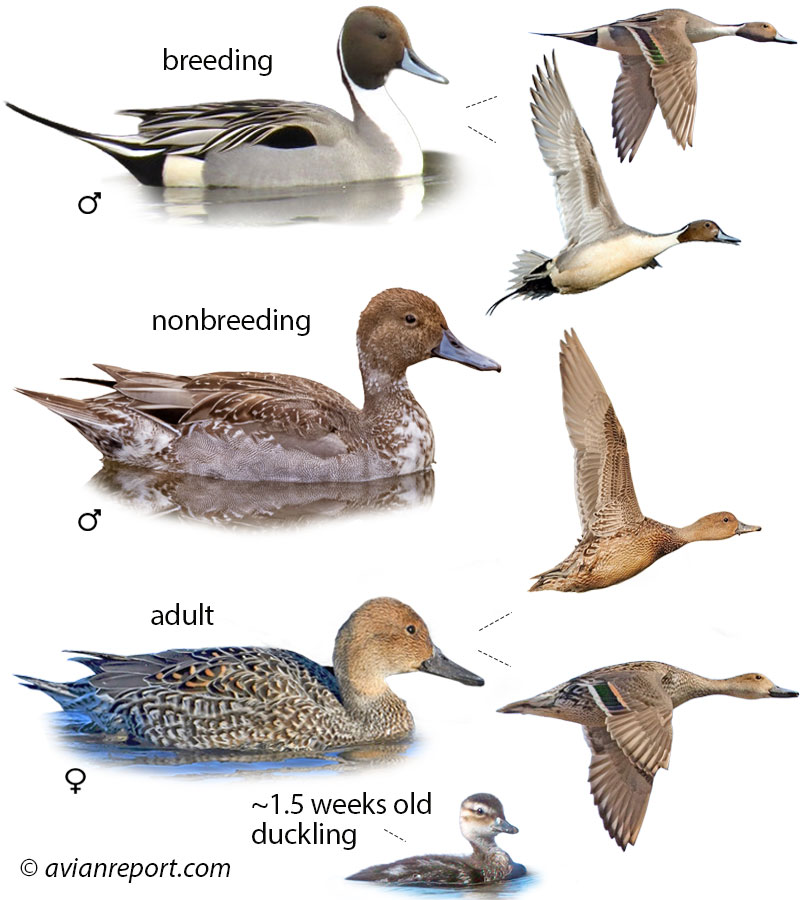
Length: 25 in, Weight: 34.4 oz, Wingspan: 34 in
Identification: Drake: chocolate head/neck, white breast/stripe down neck, long pointed tail. Hen/immature: mottled brown, pale tan face, bluish-gray bill.
Compare: The hen is similar to other hen teals and hen Mallard, Mottled and American Black Ducks. The hen Pintail has a warmer brown head, long neck, and distinctive bluish-gray bill.
Behavior: Dabbling duck. Forages on surface or tips up, filters food with bill. Generally social.
Flocking: The Northern Pintail is highly social, forming large, loose flocks (often hundreds) in winter. Flocks are known for fast, graceful flight in long, wavering lines or V-formations. Often feed and roost with American Wigeon.
Habitat: Seasonal wetlands, croplands, wet meadows, shortgrass prairies, lakes, estuaries, tidal marshes, flooded agricultural fields.
Range: Breeds Alaska, Canada, Great Plains; winters southern U.S. and Mexico.
Status and Movements: The Northern Pintail is a distinctive winter resident in Florida. These elegant dabblers typically arrive from northern breeding grounds in October and depart by March or April.
Diet: Aquatic plant seeds, worms, snails, crustaceans, aquatic insects, small grains.
Nest: Shallow bowl on ground, far from water. Female makes scrapes, lines nest with grasses/down.
Breeding: Egg laying: Apr-mid-Jun | Clutch: 3-12 eggs | Broods: 1 brood | Eggs: Greenish buff | Incubation: 22-24 days.
Lifespan: At least 22 years, 3 months.
Population: Global breeding population estimated at 5.1 million individuals.
Green-winged Teal (Anas crecca)
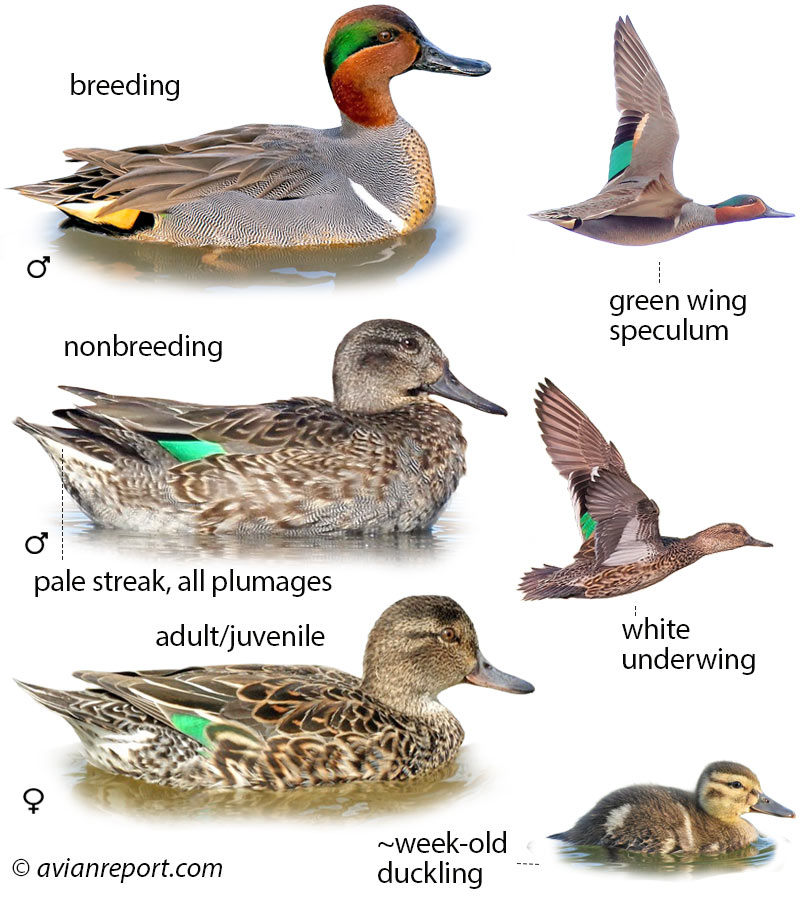
Length: 14 in, Weight: 11.3 oz, Wingspan: 22 in
Identification: Smallest dabbling duck. Drake: cinnamon head, gleaming green eye crescent, white vertical stripe on shoulder. Hen: mottled brown, yellowish tail streak. Both show green speculum.
Compare: Hen is similar to other teals and hen Mallard but differs due to a tiny size, darker overall, and green wing speculum.
Behavior: Dabbling duck. Forages shallow wetlands by tipping up or picking while standing in puddles. Quite vocal. Pairs form fall/winter.
Flocking: The Green-winged Teal is highly gregarious, forming tight, dense flocks of up to hundreds of birds. Flocks perform fast, highly erratic movements and sudden, synchronized turns in flight; renowned for their speed and agility.
Habitat: Shallow ponds, flooded fields, coastal marshes, estuaries, river deltas, boreal forest wetlands, sedge meadows, beaver ponds.
Range: Breeds widely across northern North America (Canada/Alaska). Winters in southern U.S. and Mexico.
Status and Movements: The Green-winged Teal is a common winter resident across Florida. Small and swift, they are typically present from late fall through early spring, frequenting shallow freshwater habitats statewide.
Diet: Aquatic invertebrates, seeds, sedge fruit, pondweeds, grasses, rice, corn.
Nest: Well-concealed depression on ground, typically within 200 yards of water. Lined with grasses, sedges, leaves, down.
Breeding: Egg laying: mid-Apr-late Jul | Clutch: 6-9 eggs | Broods: 1-2 | Eggs: Creamy white to pale olive-buff | Incubation: 20-23 days.
Lifespan: At least 20 years, 3 months.
Population: Global breeding population estimated at 6.7 million individuals.
Subgroup: Whistling-Ducks (Tree Ducks)
The Whistling-Ducks are a unique and highly tropical presence in Florida. They are often described as being part duck and part goose due to their long legs, upright posture, and strong pair bonds. True to their alternate name, “Tree Ducks,” they frequently perch in trees and are one of the few ducks that readily nest in tree cavities or nest boxes.
Black-bellied Whistling-Duck (Dendrocygna autumnalis)
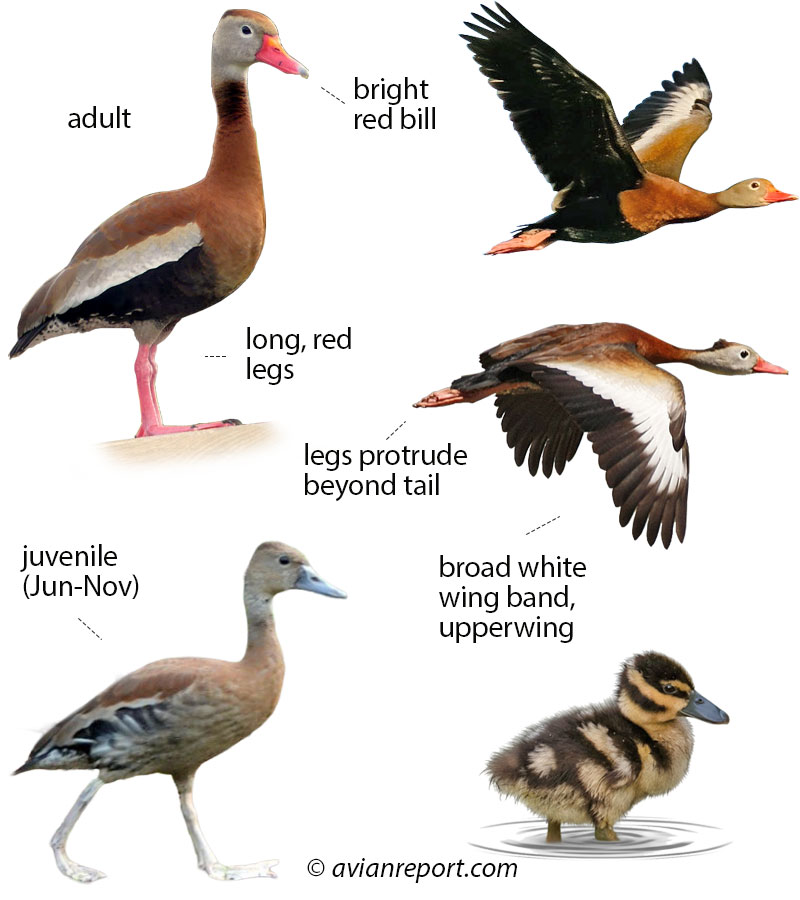
Length: 19.3 in, Weight:30 oz, Wingspan: N/A
Identification: Chestnut neck, back, and breast, black belly, bright pink bill/legs, grayish face, white wing stripe. Immatures duller, dark bill, pale breast, mottled black belly.
Compare: Structurally similar to a Fulvous Whistling Duck, which lacks the black belly and has dark bill and legs.
Behavior: Forages for waste grain, often nocturnal. Gregarious year-round. Forms lifelong pair bonds. Perches in trees/on logs.
Flocking: The Black-bellied Whistling Duck is highly social, forming large, noisy flocks. They fly low and slowly with shallow, rhythmic wingbeats, often in loose V-formations or long lines, giving continuous whistling calls. Flocks travel from feeding fields to roosts around sunset.
Habitat: Shallow ponds, agricultural/rice fields, golf courses, city parks, schoolyards. Mesquite, willow, live oak thickets. Mangroves, rivers, lagoons.
Range: Occurs in several southern U.S. states; Black-bellied Whistling-Duck range expanding northward.
Status and Movements: The Black-bellied Whistling Duck is an increasingly common year-round resident in Florida. These unique ducks are found statewide throughout all seasons.
Diet: Plants: smartweed, grasses, sedges. Crops: corn, rice, wheat, sorghum, millet. Invertebrates.
Nest: Tree hollows/cavities or nest boxes used. Ground nest is grass scrape. No material typically added in cavities.
Breeding: Egg laying: Apr-Sep | Clutch: 9-18 eggs | Broods: 1-2 | Eggs: White | Incubation: 25-30 days.
Lifespan: At least 10 years, 7 months.
Population: Global breeding population estimated at 1 million Black-bellied Whistling-Ducks.
Fulvous Whistling-Duck (Dendrocygna bicolor)
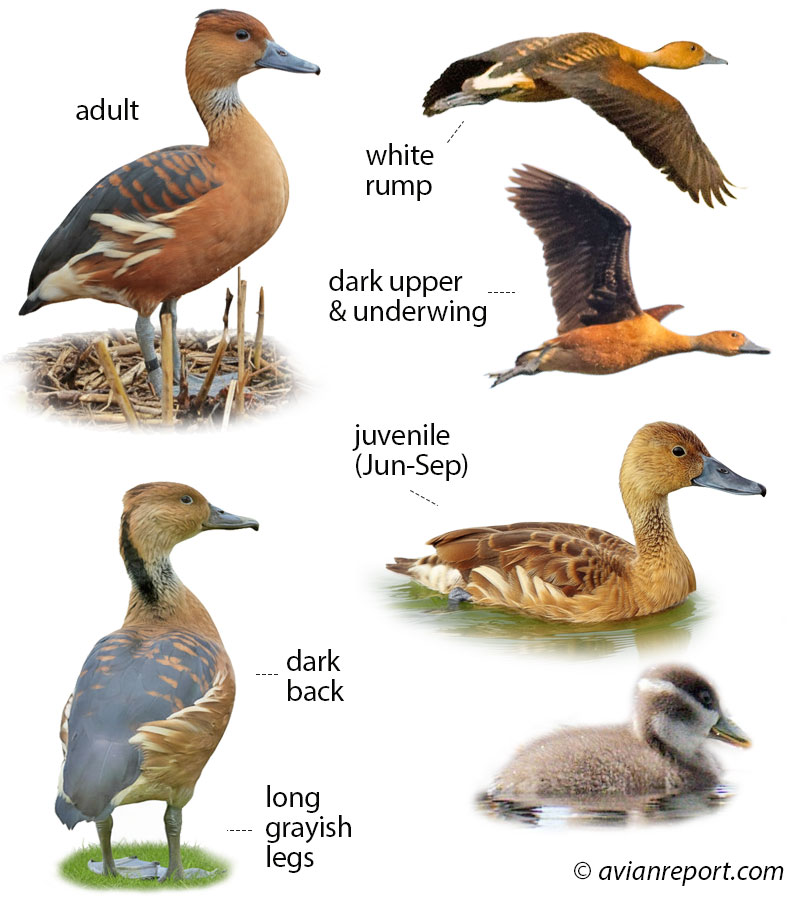
Length: 18.3 in, Weight: 27 in, Wingspan: N/A
Identification: Rich caramel-brown/black, long-necked, long-legged. Broad black bars wings/back, long white flank stripes, dark bill/legs. Hen crown/neck slightly blacker than drake.
Compare: Structurally similar to a Black-bellied Whistling Duck but lacks the black belly and has bill and legs dark.
Behavior: Often forages at night. Filter-feeds fine mud for seeds/invertebrates. Pairs probably monogamous, year-round bond.
Flocking: The Fulvous Whistling-Duck is highly gregarious, forming large, tightly packed flocks (often hundreds) outside the breeding season. Flies with shallow, continuous wingbeats in long lines or V-formations, accompanied by constant, high-pitched keweeeee calls.
Habitat: Rice fields, freshwater marshes, flooded pastures, crayfish farms. Coastal lagoons, flooded savannas, mangrove swamps.
Range: Central Florida (year-round); coastal Texas/Louisiana (spring/fall). Migrates/winters in Mexico/Central America. The Fulvous Whistling-Duck is widespread globally.
Status and Movements: The Fulvous Whistling Duck is a localized year-round resident in Florida. Though present year-round, its distribution can be somewhat nomadic, particularly within the southern half of the state’s wetlands.
Diet: Aquatic plant seeds, green algae, grains, sedges, grasses. Invertebrates.
Nest: Both sexes build platform of bent stalks, bowl shape, dead marsh grasses. Found in rice fields, reeds, or floating vegetation.
Breeding: Egg laying: Apr-Aug | Clutch: 2-44 eggs | Eggs: White to buffy white | Incubation: 24-25 days.
Lifespan: At least 11 years, 2 months.
Population: Global breeding population estimated at 1.4 million Fulvous Whistling-Duck individuals.
Native Specialized Dabblers
Wood Duck (Aix sponsa)

Length: 20 in, Weight: 23.2 oz, Wingspan: 27 in
Identification: Drake vivid colors: glossy green head, white stripes, chestnut breast, buff sides. Hen gray-brown, white-speckled breast. Juveniles are similar. Unique crested head. The Wood Duck is often called a “perching duck,” but feeds primarily by dabbling.
Compare: The hen Wood Duck is similar to many other hen ducks, but is distinguished by a bold eye ring, distinctive gray crest, and longish tail. Habitat choice is crucial.
Behavior: Dabbling duck, dives shallowly. Perches, nests in trees. Head jerks when swimming. Pairs form January; bond dissolves after eggs laid.
Flocking: The Wood Duck is less gregarious than many ducks; typically found in pairs or small, loose family groups. Larger flocks (50+) may form during fall migration or roosting at dusk. Flight is fast, direct, and often through dense timber.
Habitat: Wooded swamps, marshes, streams, beaver ponds, small lakes, tree cavities, forested wetlands, bottomland forests.
Range: Found in wooded swamps, streams, and lake edges across North America.
Status and Movements: The Wood Duck is a widespread year-round resident in Florida. Its populations are significantly augmented by wintering migrants from northern breeding grounds, present from fall through spring in forested wetlands.
Diet: Seeds, fruits, insects, arthropods. Acorns, soybeans, smartweed, duckweed, millet, grain, wild cherries, beetles, snails.
Nest: Tree cavity or woodpecker hole, 2–60 feet high. Lined with down feathers and wood chips.
Breeding: Egg laying: early Apr-Jun (Pairs form Jan) | Clutch: 6-16 eggs | Broods: 1-2 broods | Eggs: Glossy creamy white to tan | Incubation: 28-37 days. Egg-dumping common, especially in nest boxes.
Lifespan: At least 22 years, 6 months.
Population: Estimated at approximately over 3 million birds.
DIVING DUCKS OF FLORIDA
The Diving Ducks are built for life beneath the water’s surface. Unlike dabblers, their legs are set far back on their bodies, which provides maximum propulsion underwater but makes them clumsy on land. To take flight, they must run, or “patter,” across the water’s surface to gain enough speed. This group primarily forages in deeper lakes, large rivers, and coastal bays.
Core Florida Diving Ducks (Aythya)
Canvasback (Aythya valisineria)

Length: 21 in, Weight: 43.2 oz, Wingspan: 33 in
Identification: Drake: Rusty head/neck, gleaming whitish body, black chest/rear. Hen: Grayish/brown body, dark eyes. Both have long sloping foreheads and black bill.
Compare: Redheads have a similar color pattern but are smaller, with a steeper forehead, a gray (not white) back, and a bluish (not black) bill.
Behavior: Diving duck, gregarious nonbreeding season. Dives underwater constantly. Rarely goes ashore. It often forms large rafts.
Flocking: The Canvasback is highly social, forming massive, dense rafts (thousands) on large lakes. Flocks fly in long, swift, oblique lines or V-formations with powerful, sustained speed. They are the fastest fliers of North American ducks.
Habitat: Lakes, deep-water marshes, ponds, estuaries, coastal waters, lagoons, rivers, flooded agricultural fields.
Range: Breeds lakes/marshes Prairie Pothole Region, Canada, Alaska. Winters US coasts/inland waters, Mexico. This Canvasback is widespread.
Status and Movements: The Canvasback is an uncommon winter resident in Florida. These distinctive diving ducks arrive in late fall, utilizing large open waters for foraging, and depart northward by early spring, typically March.
Diet: Plant tubers, rhizomes, aquatic plant seeds, wild celery, mussels, clams, insects.
Nest: Large bulky platform of sedges, reeds, rushes. Loosely woven, floats on water, attached to emergent stalks.
Breeding: Egg laying mid Apr-early Jul | Clutch: 5-11 eggs | Broods: 1 | Eggs: Greenish drab | Incubation: 24-29 days.
Lifespan: At least 22 years, 7 months.
Population: Estimated breeding population is 566,000.
Redhead (Aythya americana)
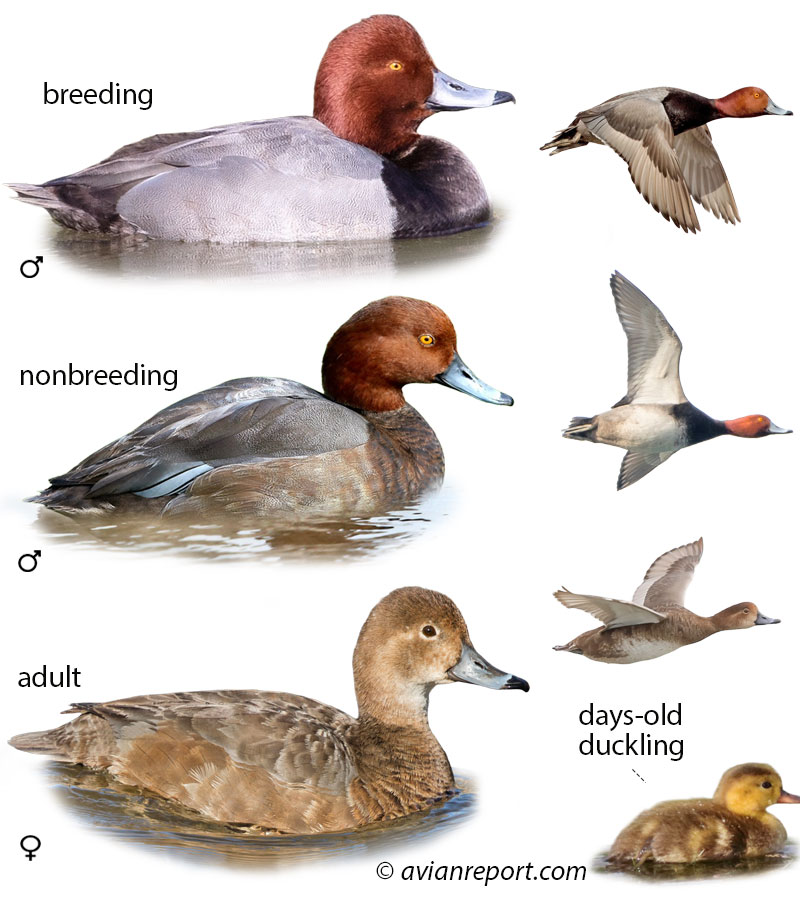
Length: 19 in, Weight: 37 oz, Wingspan: 30 in
Identification: Drake: Gleaming cinnamon head, black breast/tail, neat gray body. Hen/immature: uniform brown. Both sexes: black-tipped, gray bill, smoothly rounded head.
Compare: Canvasbacks have a similar color pattern but are larger, with a sloping forehead (triangular head), a white (not gray) back, and a black (not bluish) bill.
Behavior: Sociable duck. Usually dives for food, may tip up in shallow water like dabbling ducks. Monogamous; males court female with gymnastic “head throw” display.
Flocking: The Redhead is highly social, forming large, dense rafts on open water (often thousands). Flocks fly in tight, changing patterns or long, wavy lines with rapid, shallow wingbeats. Often flies with scaups and Canvasbacks.
Habitat: Seasonal wetlands, prairie potholes, deep marsh, large lakes, reservoirs, coastal bays, Gulf Coast, agricultural fields.
Range: Breeds Great Plains/Midwest prairie pothole region, West. Winters Gulf Coast, Great Lakes, southern U.S. waters.
Status and Movements: The Redhead is a common winter resident across Florida. These striking diving ducks arrive in fall, favoring coastal bays and large freshwater lakes, and depart for northern breeding grounds by early spring.
Diet: Submerged aquatic plants, green algae. Invertebrates: snails, zebra mussels, mayflies, small clams.
Nest: Circular woven bowl built by female using plant material on an underwater vegetation foundation. Found in cattails/bulrushes over water.
Breeding: Egg laying: May-late Jul | Clutch: 7-8 eggs | Broods: 1 | Eggs: Creamy white to pale, olive buff/buffy brown | Incubation: 22-28 days
Lifespan: At least 20 years, 7 months.
Population: North American population estimated at 1.2 million Redhead individuals (2015).
Ring-necked Duck (Aythya collaris)
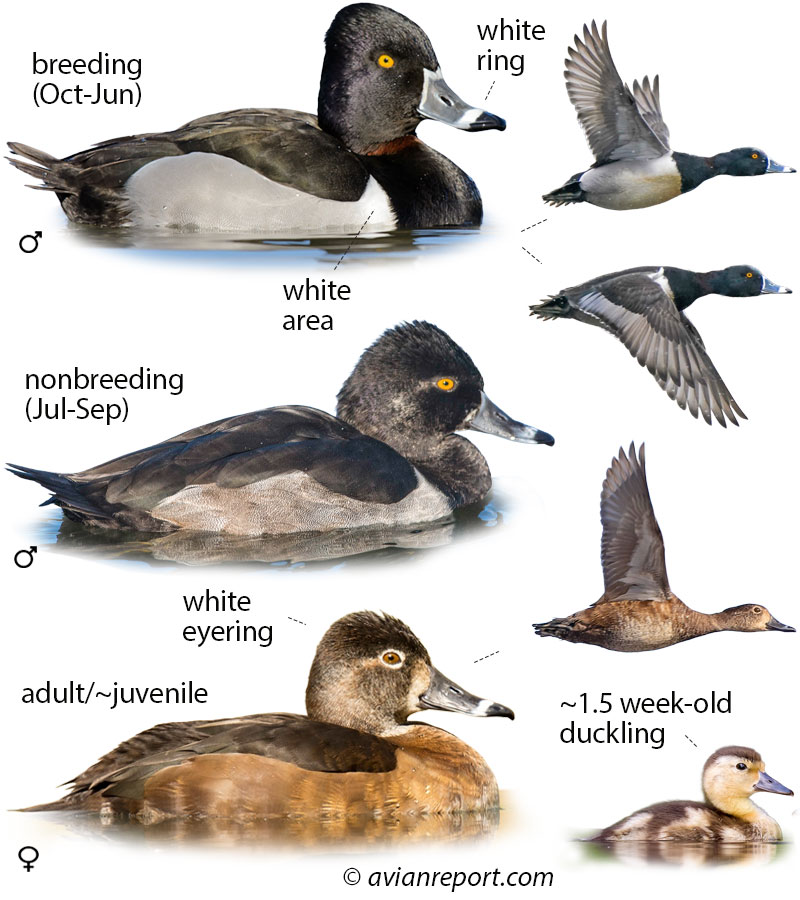
Length: 17 in, Weight: 25 oz, Wingspan: 25 in
Identification: Drake: black/gray, peaked head, prominent white bill ring, black back, white chest (area) spur. Hen: rich brown, pale cheek, whitish eye ring/bill patch.
Compare: Drake Lesser Scaups have a pale back, lack the white side spur, and the white band and black tip of the bill of the Ring-necked. Hen scaups have a solid dark-brown head, not the capped look of the hen Ring-necked Duck.
Behavior: Diving duck. Forages diving for mollusks, invertebrates, submerged vegetation. Uses displays (head throw, nodding) for courtship and rival warnings.
Flocking: The Ring-necked Duck typically forms medium-sized flocks, flying swiftly and directly in loose V-formations or irregular groups. Their agile flight, characterized by quick wingbeats, makes them appear energetic.
Habitat: Freshwater marshes, bogs, beaver ponds, shallow lakes, flooded agricultural fields, cattle ponds, river floodplains, brackish estuaries, reservoirs.
Range: Breeds far northern North America boreal forest. Winters widely US inland/coastal waters, Mexico, Central America/Caribbean.
Status and Movements: The Ring-necked Duck is an abundant winter resident throughout Florida. Arriving in October, these common diving ducks frequent freshwater wetlands and depart by late March or early April for their northern breeding areas.
Diet: Submerged plants and seeds, aquatic invertebrates, mollusks, earthworms, leeches.
Nest: Simple bowl of sedges/plants on/over water or floating vegetation. Flimsy collection of bent stems, lined with down feathers.
Breeding: Egg laying: early May-mid-Jul | Clutch: 6-14 eggs | Broods: 1 | Eggs: N/A | Incubation: 25-29 days.
Lifespan: At least 20 years, 5 months.
Population: Global breeding population estimated at 2 million individuals.
Greater Scaup (Aythya marila)
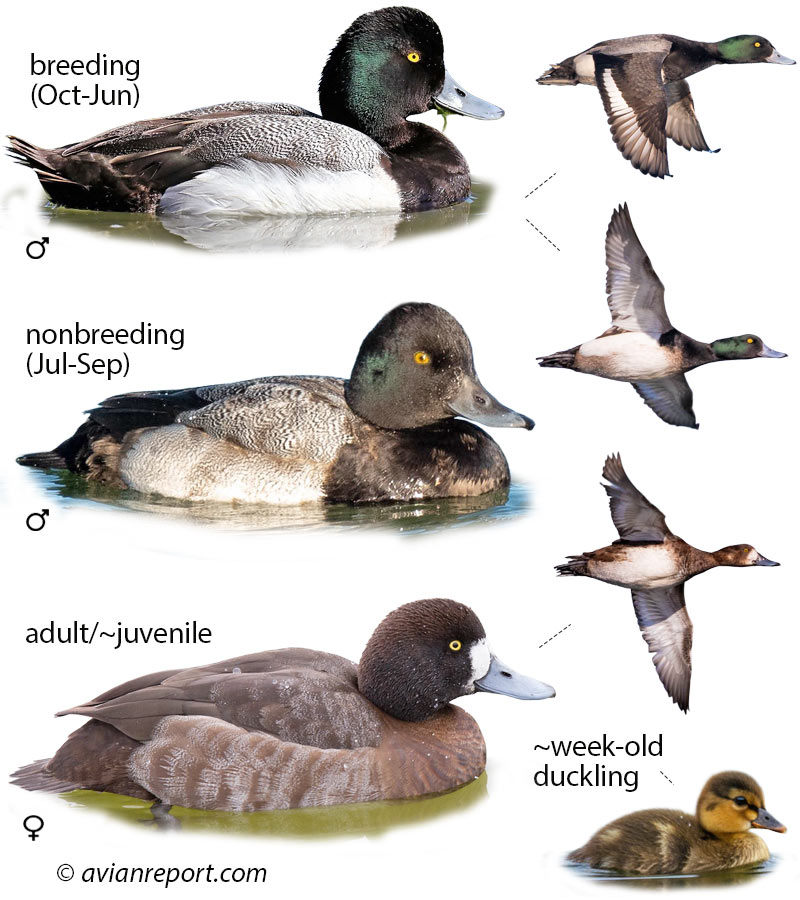
Length: 19 in, Weight: 37 oz, Wingspan: 30 in
Identification: Drake black/white, rounded head, iridescent green sheen. Blue bill, yellow eye. Hen brown, darker head, variable white bill patch. Nonbreeding mottled gray/brown.
Compare: Drake and hen Lesser Scaup usually show a peak at the back of the head, while Greater Scaup has a more smoothly rounded head. Overall, very similar species.
Behavior: Diving duck. Forages underwater for aquatic invertebrates/plants, diving up to 23 feet. Monogamous seasonally; pairs form in winter.
Flocking: Greater Scaup are highly gregarious, often forming immense, dense rafts. Their powerful, fast flight occurs in coordinated, tightly packed flocks, often shifting patterns over water, exhibiting strong, direct movement.
Habitat: Shallow lakes, ponds, treeless wetlands, tundra. Coastal bays, reservoirs, Great Lakes, Pacific/Atlantic shorelines.
Range: Breeds North American tundra. Winters Pacific/Atlantic coasts, Great Lakes, reservoirs.
Status and Movements: The Greater Scaup is an uncommon winter visitor in Florida, favoring coastal waters. Arriving later in fall, these large diving ducks are typically present from November through early spring before migrating north.
Diet: Aquatic invertebrates, mollusks, insects, crustaceans. Aquatic plants, seeds.
Nest: Saucer-shaped depression on ground, near water, dense cover. Lined with grasses, plant material, downy feathers.
Breeding: Egg laying: mid-May – late Aug | Clutch: 5-13 eggs | Broods: 1 | Eggs: Brownish olive-buff | Incubation: 23-28 days.
Lifespan: At least 20 years, 5 months.
Population: Estimated 780,000 individuals. The Greater Scaup is listed as a common bird in steep decline.
Lesser Scaup (Aythya affinis)
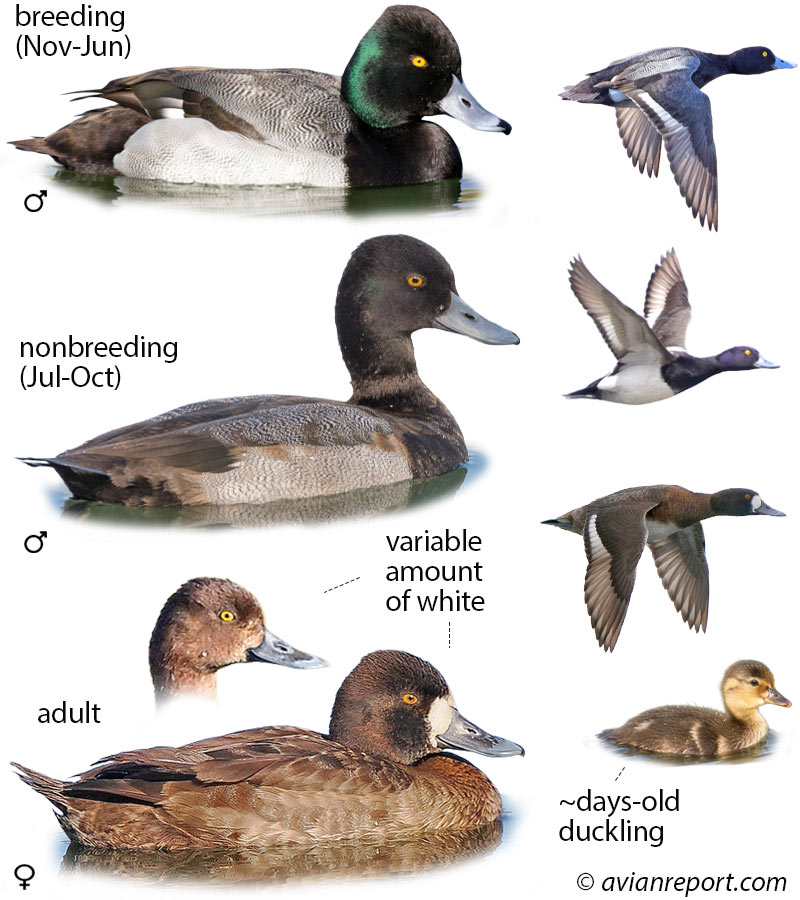
Length: 17 in, Weight: 27 oz, Wingspan: 29 in
Identification: The Lesser Scaup Drake: Black/white, peaked head, iridescent purple/green sheen, bluish bill/yellow eye. Hen: brown, pale bill patch variable.
Compare: Drake and hen Greater Scaup usually show a more rounded head, while Lesser Scaup shows a peak at the back of the head. Overall, very similar species.
Behavior: Diving duck. Sleeps on water. Seasonally monogamous, new mates yearly. Drakes display vigorously courting females.
Flocking: The Lesser Scaup typically forms smaller, yet still gregarious, flocks than its larger cousin. They fly swiftly and directly, often in erratic or loose V-formations with rapid wingbeats, showing agile aerial maneuvers.
Habitat: Prairie potholes, boreal forest, tundra wetlands, hayfields. Lakes, reservoirs, coastal bays, estuaries, agricultural ponds.
Range: Breeds Northern North America/Prairie Potholes. Winters US inland/coastal waters, extending south to Central America/Caribbean.
Status and Movements: The Lesser Scaup is Florida’s most abundant wintering diving duck. Arriving in October, they are widespread across freshwater and coastal habitats, departing for breeding grounds by April.
Diet: Aquatic invertebrates: mollusks, insects, crustaceans. Aquatic plants, seeds.
Nest: Saucer-shaped depression on ground in tall, well-concealed vegetation (prairies/marshes). Lined with grasses and female down.
Breeding: Egg laying: late May-Jul | Clutch: 6-14 eggs | Broods: 1 | Eggs: Pale to dark olive/greenish buff | Incubation: 21-27 days.
Lifespan: At least 18 years.
Population: Global breeding population estimated at 3.8 million individuals.
Subgroup: Sea Ducks and Scoters
Though most often associated with northern coasts, the Sea Ducks occasionally winter in Florida’s coastal waters. This subgroup, which includes the heavy-bodied Scoters and the buoyant Bufflehead and Goldeneye, is primarily found in saltwater environments where they dive deep to feed on mollusks and crustaceans.
Common Eider (Somateria mollissima)
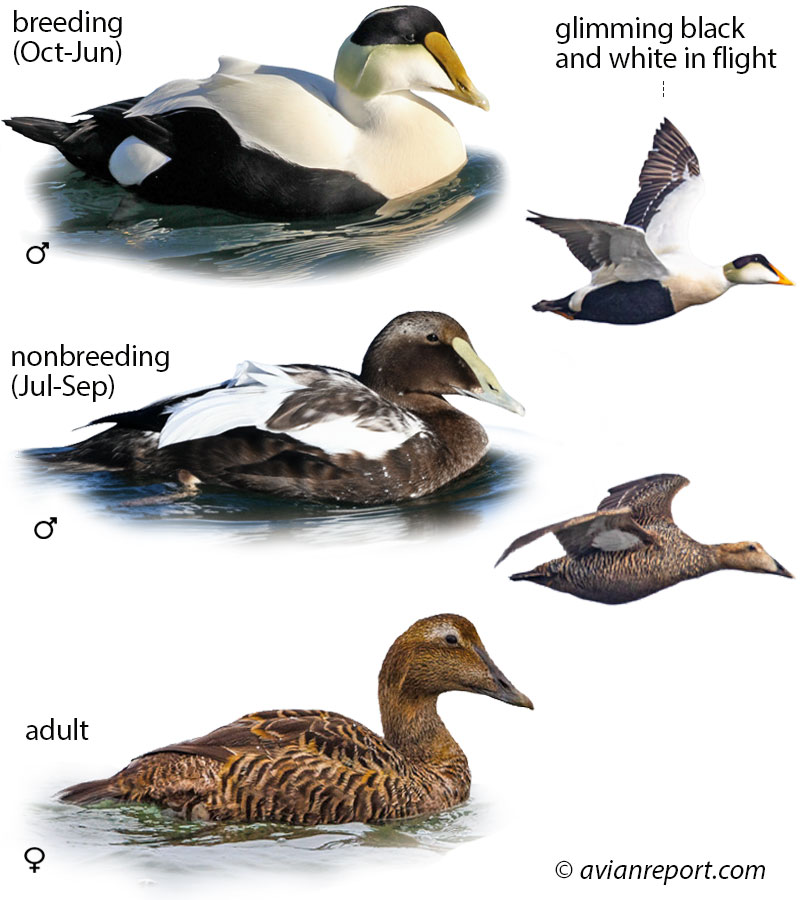
Length: 24 in, Weight: 69 oz, Wingspan: 38 in
Identification: Largest sea duck. Drake: white/black, black cap, pale green nape, sloping bill. Hen: warm brown, densely black-barred, black bill. Immature males chocolate brown.
Compare: Drake King Eiders have a black back and a more square and colorful head than Common Eiders. Hen King Eiders have a more rounded head and long sloping forehead.
Behavior: Diving duck, use wings to swim, pry mussels/shellfish from rocks. Spend much day resting/loafing. Drakes croon softly courting.
Flocking: Common Eiders are highly social, forming large, often dense, rafts. Their powerful, direct flight is usually low over the water in long, undulating lines or irregular groups, exhibiting strong, deliberate wingbeats for sustained movement.
Habitat: Rocky ocean coasts, islands, estuaries, bays, Arctic tundra heath, taiga, gravel spits, rocky seafloors.
Range: Breeds Alaska/Canada Arctic tundra. Winters Atlantic Canada, New England, S. Alaska coasts. The Common Eider is rare south of mid-Atlantic states.
Status and Movements: The Common Eider is an exceedingly rare winter vagrant in Florida, typically found along the Atlantic coast. Records are scarce and highly localized, occurring primarily from late fall through early spring.
Diet: Mollusks (blue mussels), crustaceans (spider crabs), echinoderms (sea urchins), marine worms, fish eggs, marine algae.
Nest: Ground depression, usually covered (rock/vegetation), near sea. Lined with down (after 3rd egg). Nests in large colonies (Atlantic).
Breeding: Egg laying: Jun – mid-Jul | Clutch: 3-8 eggs | Broods: 1 | Eggs: Olive or greenish | Incubation: 24-26 days.
Lifespan: At least 22 years, 7 months.
Population: North American breeding
Population: 750,000 individuals.
Surf Scoter (Melanitta perspicillata)

Length: 21 in, Weight: 39 oz, Wingspan: 30 in
Identification: Drake jet black, orange/white/black bill, white nape/forecrown patches. Hen dark brown, dark bill, usually two white face patches.
Compare: White-winged Scoters have a large white patch in the wing that Surf Scoters lack. Surf Scoters have distinctive white patches on the forehead and back of the neck. Hens have a darker cap than White-winged Scoters.
Behavior: Dives for prey, often just before ocean waves break. Rests on water. Drake defends moving area around hen during breeding.
Flocking: Surf Scoters typically form smaller flocks, often flying in loose, undulating lines or irregular groups low over the waves. Their direct, powerful flight exhibits purposeful movement, characterized by strong, steady wingbeats. Roosts miles offshore nightly.
Habitat: Taiga shield ecotone, shallow lakes, boreal forest/tundra blend, ocean coasts, bays, estuaries, inland lakes (migration/storms).
Range: Breeds N. Canada/Alaska boreal forest/tundra. Winters Atlantic/Pacific coasts, inland waters. The Surf Scoter is widespread.
Status and Movements: The Surf Scoter is an uncommon to fairly common winter resident in Florida. These distinctive sea ducks arrive in late fall, primarily frequenting coastal waters and large bays, departing by late spring.
Diet: Mollusks (mussels, clams), marine snails, crabs, worms, herring spawn. Aquatic vegetation. Freshwater invertebrates/insects (breeding).
Nest: Well concealed depression on ground. Beneath vegetation/rocky ledges. Lined with down, moss, grasses, needles, twigs, bark.
Breeding: Egg layin: mid May – mid-Aug | Clutch: 6-9 eggs | Broods: 1 | Eggs: Creamy white | Incubation: 28-30 days.
Lifespan: At least 19 years, 7 months.
Population: Global breeding population estimated at 470,000 individuals.
White-winged Scoter (Melanitta deglandi)
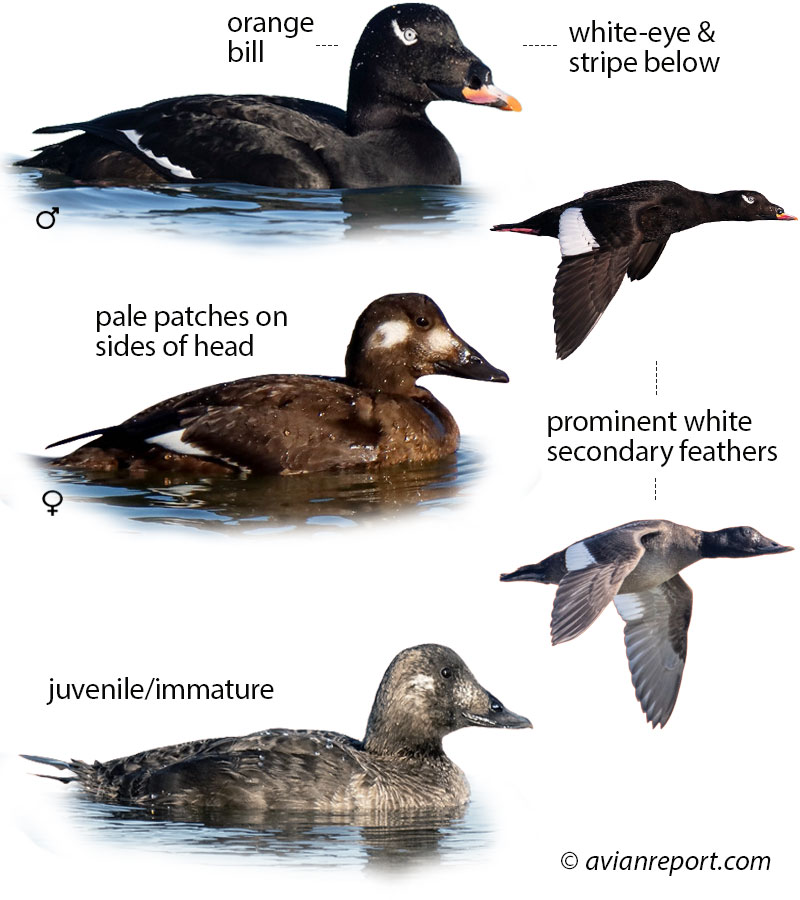
Length: 21 in, Weight: 49 oz, Wingspan: 32 in
Identification: Drake velvety black, white comma eye patch, orange-tipped bill, white wing patch. Hen dark brown, two smudgy white face patches. Juveniles similar to hens.
Compare: Drake Surf Scoters have a large white patch on the forehead and back of the neck that Drake White-winged Scoters lack. Hens have a uniform dark head that contrasts with the dark-capped head of a hen Surf Scoter.
Behavior: Forages diving deep underwater. Swallows prey whole underwater. Winters in flocks. Monogamous mating system presumed.
Flocking: White-winged Scoters typically form small, loose flocks, flying with strong, direct wingbeats. Their flight is powerful and steady, often staying low over coastal waters, occasionally gathering in larger, dispersed rafts.
Habitat: Boreal forest, shallow freshwater lakes, brushy shrubs (breeding). Coastal areas, shallow saltwater bays, estuaries, Great Lakes (winter).
Range: Breeds Northern Canada/Alaska boreal forest. Winters Atlantic/Pacific coasts, Great Lakes, inland waters. This White-winged Scoter is widespread.
Status and Movements: The White-winged Scoter is an uncommon winter resident in Florida. This large sea duck arrives in late fall, preferring offshore coastal waters and estuaries, and typically departs by early spring.
Diet: Mollusks (mussels, clams, snails), crustaceans, fish, insects (freshwater: caddisflies/midges), aquatic plants (small amounts).
Nest: Depression in soil, beneath heavy, thorny vegetation (roses/berry bushes). Fluffy bowl of down/grasses/twigs.
Breeding: Egg laying: Jun-mid-Aug | Clutch: 6-16 eggs | Broods: 1 | Eggs: Creamy buff or light pink | Incubation: 28-30 days.
Lifespan: At least 18 years, 1 month.
Population: Global breeding population estimated at 400,000 individuals.
Black Scoter (Melanitta americana)

Length: 18 in, Weight: 35 oz, Wingspan: 28 in
Identification: Drake all jet black, orange knob at base of bill. Hen dark brown, pale face and delineated dark cap.
Compare: White-winged Scoters have a white patch in the wing that Black Scoters lack. The orange bill knob in Black Scoters is distinctive. Hen Black Scoter have a pale face and delineated dark cap.
Behavior: Dives for shellfish/mussels (winter); marsh insects (summer). Drakes vocal, croon. Monogamous, males closely guard mates.
Flocking: Black Scoters gather in moderate to large flocks, maintaining tight, often crescent-shaped flight patterns. They exhibit strong, direct flight with steady, powerful wingbeats, frequently moving low over the water in cohesive groups.
Habitat: Coastal ocean waters, bays, inland lakes/rivers, boreal forest lakes, shallow water, rocky bottoms.
Range: Breeds far north boreal forest/tundra; winters Atlantic/Pacific coasts, Great Lakes, inland waters, scarce southern US.
Status and Movements: The Black Scoter is a fairly common winter resident in Florida, especially along the Atlantic coast. This diving duck typically arrives in late fall, utilizing nearshore ocean waters and large bays until early spring.
Diet: Mollusks (mussels, clams, scallop), crustaceans, insects/larvae, fish eggs, marine vegetation (eelgrass).
Nest: Depression on ground, grassy/sheltered spot, usually <100 feet from water. Lined with female’s down feathers.
Breeding: Egg laying: mid-May – mid-Aug | Clutch: 8-9 eggs | Broods: 1 | Eggs: Off-white to pinkish buff | Incubation: 27-28 days.
Lifespan: At least 10 years, 6 months.
Population: Global breeding population estimated at 900,000 individuals.
Bufflehead (Bucephala albeola)
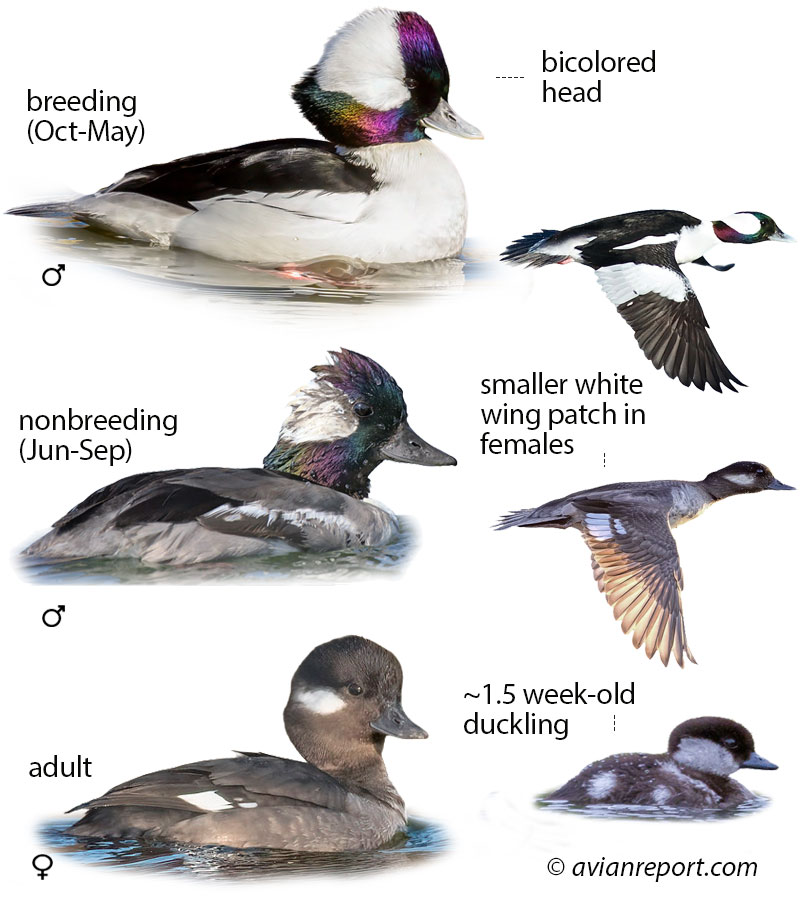
Length: 14 in, Weight: 16 oz, Wingspan: 22 in
Identification: Drake: White body, black back, glossy green/purple head, large white patch. Hen/immature: gray-brown, oval white cheek patch.
Compare: Drake Hooded Mergansers have cinnamon (not white) sides and a longer, thinner bill than Drake Buffleheads. The hen Bufflehead has a dark round head and single white patch on the cheek.
Behavior: The Bufflehead dives underwater for aquatic invertebrates. Monogamous; pairs often last several years. Males rapidly bob heads courting hens.
Flocking: Buffleheads are typically found in small, scattered groups or pairs, rarely forming large flocks. Their flight is remarkably fast and erratic, characterized by rapid, whirring wingbeats and sudden, darting movements, especially when flushed.
Habitat: Buffleheads occupy boreal forests, aspen parkland lakes/ponds. Winter: shallow saltwater bays, estuaries, large lakes, inland ponds.
Range: Breeds Canada/Alaska boreal forest; isolated western U.S. populations. Winters coasts/large inland waters across southern North America.
Status and Movements: The Bufflehead is a common winter resident throughout Florida. These small, buoyant diving ducks arrive in late fall, inhabiting a variety of freshwater and saltwater habitats, and depart by early spring.
Diet: Aquatic invertebrates, shrimp, crabs, mussels, fish eggs, small fish. Plant seeds (pondweeds/bulrushes).
Nest: Nests exclusively in tree cavities, primarily old Northern Flicker holes. Female lines cavity with down.
Breeding: Egg laying: late Apr-mid-Jul | Clutch: 4-17 eggs | Eggs: Cream-colored or buff; unmarked.
Lifespan: At least 18 years, 8 months.
Population: Global breeding population estimated at 1.3 million individuals.
Common Goldeneye (Bucephala clangula)
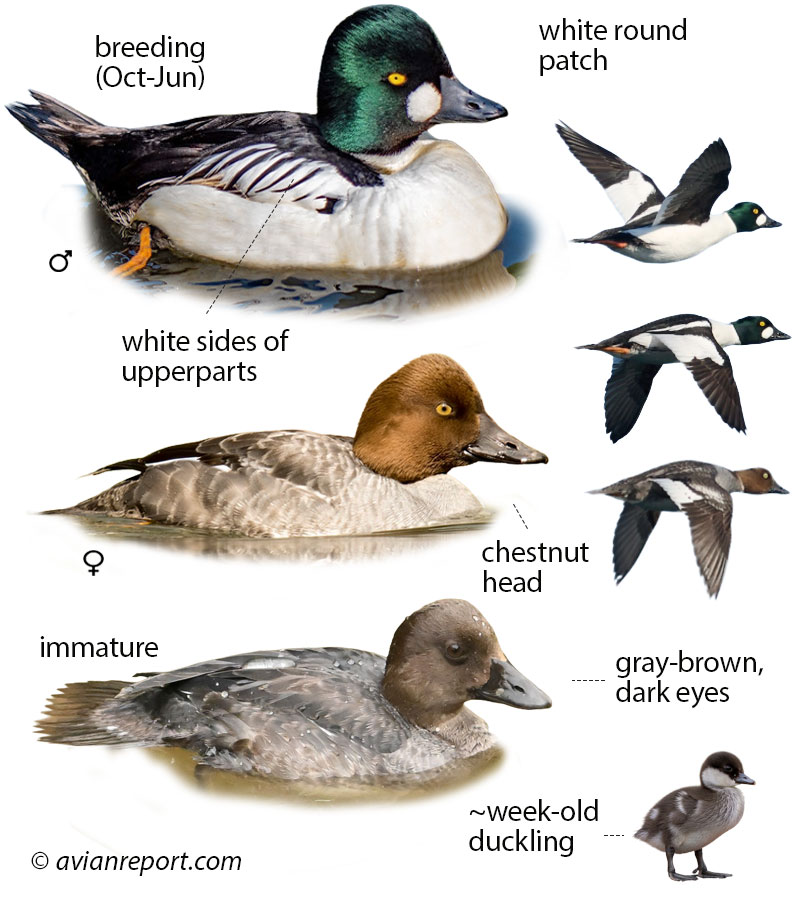
Length: 18 in, Weight: 34 oz, Wingspan: 32 in
Identification: Drake: Green-black head, round white spot, radiant amber eye, crisp black/white body/wings. Hen: Chocolate head, bright eye, gray body.
Compare: Barrow’s Goldeneyes have an oval or crescent-shaped white spot behind the bill whereas the spot on Drake Common Goldeneyes is round. Barrow’s also have a black spur on the side that Common Goldeneyes lack.
Behavior: Diving duck. The Common Goldeneye forages in flocks that often perform synchronized dives. Drakes display (head backward/forward) courting females.
Flocking: Forms small, loose flocks or linear formations, flying with strong, direct, and swift movements. Their rapid, whirring wingbeats propel them quickly across the water, often in cohesive, though not dense, groups of a few dozen.
Habitat: Boreal forest, tree cavities, lakes, rivers, wetlands. Winter: Protected coastal waters, large inland lakes.
Range: Breeds Canada/Alaska boreal forest, some US states. Winters Atlantic, Pacific, Gulf coasts, large inland waters.
Status and Movements: The Common Goldeneye is an uncommon winter resident in northern Florida, rarer south. This diving duck arrives in late fall, favoring larger freshwater bodies and estuaries, typically departing by early spring.
Diet: Aquatic invertebrates. Vegetation: seeds/tubers (pondweeds, bulrush).
Nest: The Common Goldeneye nests in tree cavities (natural/woodpecker holes) or nest boxes. Female lines cavity/bowl with down feathers.
Breeding: Egg laying: early Apr-mid-Jul | Clutch: 4-9 eggs | Broods: 1 | Eggs: Greenish to olive-green | Incubation: 27-33 days.
Lifespan: At least 20 years, 5 months.
Population: Global breeding population estimated at 2.5 million individuals.
Subgroup: Mergansers (Sawbill Ducks)
The Mergansers are easily distinguished by their thin, streamlined bills that are serrated, or “saw-toothed,” which gives them their nickname, “Sawbill Ducks.” This specialized bill is an adaptation for their nearly exclusive diet of fish. While they are powerful divers like the rest of the group, Mergansers in Florida can be found in a variety of habitats, from freshwater lakes and rivers (Hooded Merganser) to saltwater estuaries (Red-breasted Merganser).
Hooded Merganser (Lophodytes cucullatus)
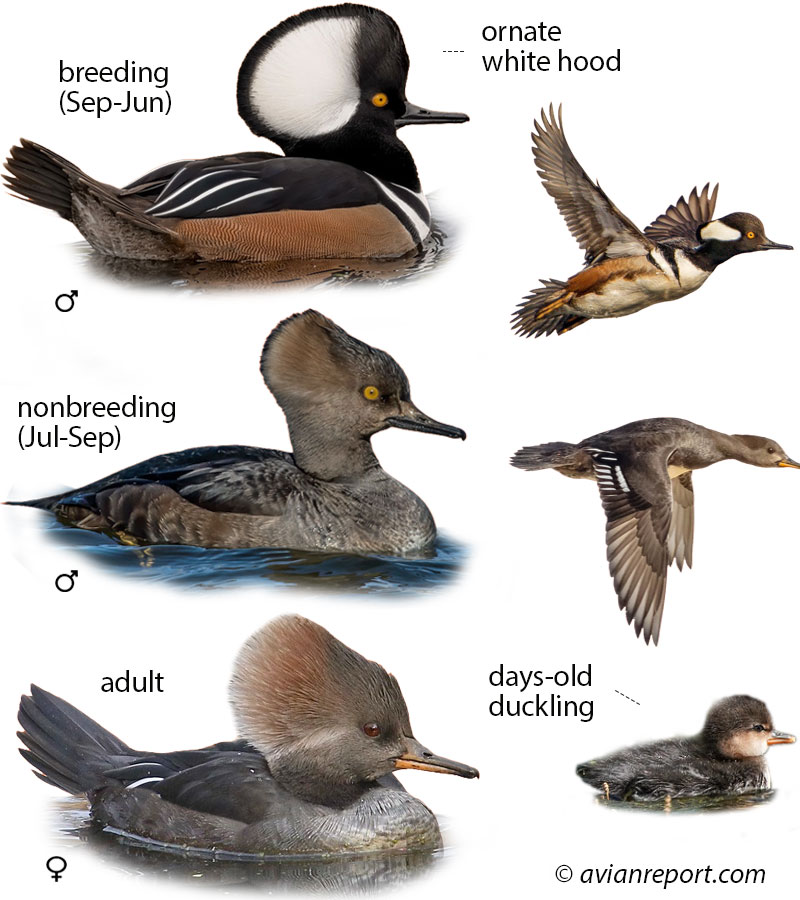
Length: 18 in, Weight: 24 oz, Wingspan: 25 in
Identification: Drake: black/white patterns, chestnut flanks, large white patch on black, fan-shaped crest. Hen/immature: gray/brown with tawny-cinnamon crest.
Compare: Drake Buffleheads have a white belly and sides whereas Drake Hooded Mergansers have cinnamon sides and a longer and thinner bill. Buffleheads are smaller. Hens Hooded Merganser are darker and smaller than hens Red-breasted and Common Mergansers.
Behavior: Busy diver. Drakes court expanding crests, making low, groaning calls. Not known if pairs reunite post-incubation. Runs across water to fly.
Flocking: Hooded Mergansers typically fly in small, often single-file groups, rarely forming large congregations. They exhibit very fast, direct flight with rapid, shallow wingbeats, displaying surprising agility as they navigate waterways with heads held low.
Habitat: Forested wetlands, small ponds, rivers, lakes, marshes, protected saltwater bays.
Range: Breeds eastern half/Pacific Northwest North America. Winters large fresh/brackish bays, US inland waters.
Status and Movements: The Hooded Merganser is a common winter resident across Florida. These striking diving ducks arrive from northern breeding grounds by October and remain through March, favoring freshwater habitats statewide, a distinct seasonal presence.
Diet: Small fish, aquatic insects, crustaceans, amphibians, mollusks, vegetation.
Nest: Tree cavity (live/dead tree, 10–90 feet high) or nest box. Female adds down to shallow bowl in cavity.
Breeding: Egg laying: Feb-early May | Clutch: 5-13 eggs | Broods: 1 brood | Eggs: White, thick shelled | Incubation: 26-41 days
Lifespan: At least 14 years, 6 months.
Population: Estimated at 1.1 million individuals.
Red-breasted Merganser (Mergus serrator)
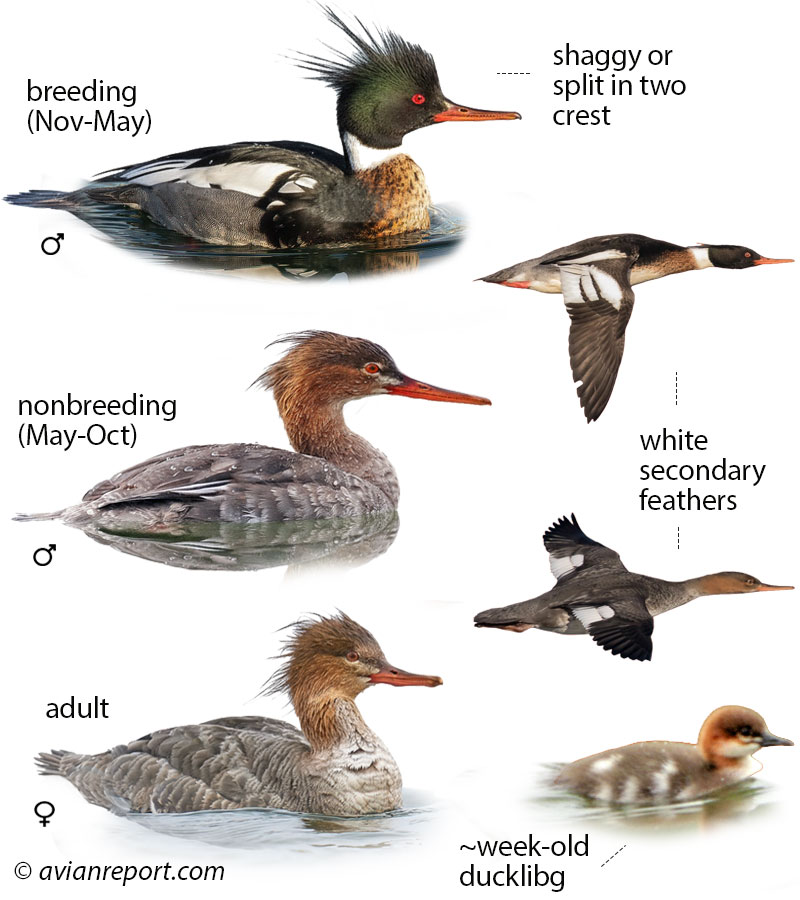
Length: 23 in , Weight: 38 oz, Wingspan: 28 in
Identification: Drake: dark green shaggy crest, red bill/eye, rusty chest, white neck band. Hen/nonbreeding male: brownish gray, brown shaggy head.
Compare: Breeding Drake Common Mergansers have white sides and a white breast whereas Drake Red-breasted Mergansers have gray sides and a cinnamon breast. Hen/nonbreeding male Common Merganser have a neat head/neck border colors; these colors blend into each other in Red-breasted Merganser.
Behavior: Dives underwater capturing prey with serrated bill. Non-territorial, social. Sits low in water. Requires running start to become airborne.
Flocking: The Red-breasted Merganser often flies in small, loose flocks or irregular lines, demonstrating strong, direct flight close to the water. Their flight is rapid and powerful, with quick wingbeats.
Habitat: Boreal forest, fresh/brackish/saltwater wetlands (breeding). Oceans, lakes, rivers, estuaries, bays (winter).
Range: Breeds boreal forest, typically near coast. Winters US coastal waters, Mexico, large inland lakes.
Status and Movements: A common winter resident, the Red-breasted Merganser graces Florida’s coastal and brackish waters. Migrants typically arrive in October and depart by April, a stark contrast to its northern breeding range, making it a reliable winter sight.
Diet: Small fish (4–6 inches long), crustaceans, insects, tadpoles.
Nest: Depression on ground under dense cover (logs/boulders/branches). Lined with dead grasses, insulating down feathers. Nests alone or in colonies.
Breeding: Egg laying: mid-May – mid-Jul | Clutch: 3-24 eggs | Broods: 1 brood | Eggs: Olive-buff | Incubation: 28-35 days.
Lifespan: At least 9 years, 6 months.
Population: Estimated at 370,000 individuals.
Subgroup: Stiff-Tailed Ducks
The Stiff-Tailed Ducks are a small, distinctive group named for their unique, rigid tail feathers that are often held upright like a sail when the birds are at rest or displaying. These ducks are highly aquatic and arguably the most specialized diving ducks in North America.
They have compact bodies, thick necks, and legs positioned so far back that they are nearly incapable of walking on land. Consequently, they spend almost their entire lives on the water, where they dive frequently and expertly propel themselves using their large feet. In Florida, the group is represented almost exclusively by the Ruddy Duck, a relatively common winter visitor. The second species in this group, the tropical Masked Duck, an extremely rare and accidental visitor to the state.
Ruddy Duck (Oxyura jamaicensis)
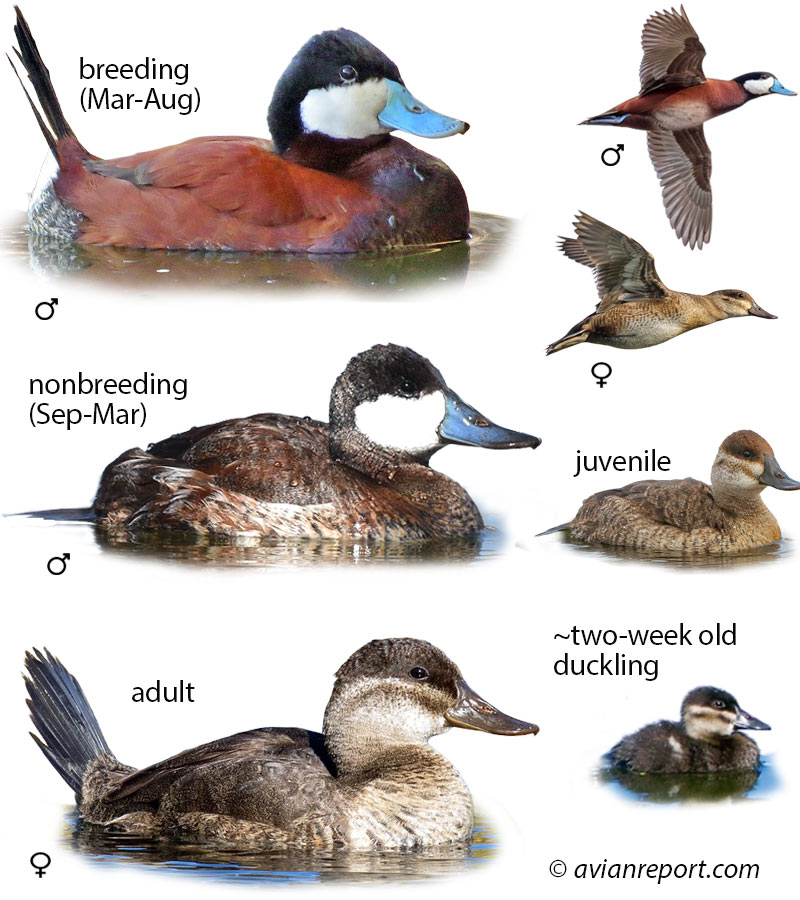
Length: 15 in, Weight: 20 oz, Wingspan: 23 in
Identification: Drake summer: chestnut body, sky-blue bill, white cheek, black cap. Winter male/Hen: dull gray-brown, blurry cheek stripe. Compact, stiff tail often held upright.
Compare: Hen Black Scoters are larger and do not hold their tail upwards like Ruddy Ducks do. Hen Buffleheads are smaller.
Behavior: Dive for aquatic invertebrates. Forages mostly nocturnally. Highly aggressive, often fight others. Courtship: bill striking neck creates water bubbles.
Flocking: The Ruddy Duck is a reluctant flyer, typically seen alone or in small groups. When aloft, it flies low over water with rapid, stiff wingbeats in a direct path, preferring to dive when disturbed.
Habitat: Marshes, reservoirs, large lakes, prairie potholes, brackish bays, coastal estuaries, ponds.
Range: Breeds prairie pothole region/western US. Winters in the southern US, extending through Mexico to Central America.
Status and Movements: The Ruddy Duck is a common winter resident throughout Florida, favoring freshwater ponds and marshes. Individuals typically arrive by October and can be observed until March, before returning to more northerly breeding areas for the breeding season.
Diet: Midge larvae, aquatic insects, crustaceans, zooplankton, worms, snails. Aquatic plants (pondweed, bulrushes), seeds.
Nest: Dry plant materials platform becomes bowl-like. Female weaves vegetation canopy over nest. Built 2–10 inches over water in cattails.
Breeding: Egg laying: N/A | Clutch: 3-13 eggs | Broods: 1-2 | Eggs: White/yellowish white, pebbly | Incubation: 20-26 days.
Lifespan: At least 13 years, 7 months.
Population: Global breeding population estimated at 1.3 million individuals.
Masked Duck (Oxyura dominica)

Length: 14 in, Weight: 13 oz, Wingspan: 17 in
Identification: Drake breeding: Chestnut body spotted with black, sky-blue bill, black face mask. Nonbreeding drake/Hen: gray-brown, blurry double cheek stripes. Compact, stiff tail often held upright.
Compare: Hen Ruddy Duck has a dark cap and single face stripe.
Behavior: Rather reclusive, feeds mainly at night and spends much of the day sleeping quietly in marshy vegetation. Seldom ventures far from cover.
Flocking: The Masked Duck is a reluctant flyer, rarely seen in flight.
Habitat: Small ponds, marshes and ditches with plenty of vegetation.
Range: Largely a tropical duck with only rare occurrences in Texas and Florida, presumably also along the Gulf Coast.
Status and Movements: The Masked Duck is a rare visitor in the State of Florida. Little is known about its erratic movements.
Diet: Midge larvae, aquatic insects, crustaceans, zooplankton, worms, snails. Aquatic plants (pondweed, bulrushes), seeds.
Nest: Dry plant materials platform becomes bowl-like. Female weaves vegetation canopy over nest. Built 2–10 inches over water in cattails.
Breeding: Egg laying: Breeds year-round | Clutch: 4-6 eggs | Eggs: White/yellowish white | Incubation: 28 days.
Lifespan: Not available.
Population: Global breeding population estimated at 16,000 to 200,000 individuals.
GEESE OF FLORIDA
Geese are easily distinguished from ducks by their larger size, longer necks, and more upright posture. Unlike ducks, geese are primarily grazers, spending much of their feeding time on land, eating grass and other short vegetation. They also form strong, lasting pair bonds and travel in tight-knit family units, giving them a much different social structure than most ducks. Florida’s mild climate and southern location mean its goose diversity is markedly lower than in northerly states. The Canada Goose is the only reliable member of this group.
Canada Goose (Branta canadensis)

Length: 37 in, Weight: 212 oz, Wingspan: 58 in
Identification: Black head, white cheeks/chinstrap, black neck, brown back. Adults: tan breast.
Compare: Cackling Geese are smaller with a smaller bill and a shorter neck than Canada Goose. Cackling Geese also have a blockier head and steeper forehead than Canada Geese.
Behavior: Dabbling in water or grazing fields/lawns. Mate for life, pairs remain together year-round. Highly social; defend territory aggressively during breeding.
Flocking: The Canada Goose is highly gregarious, flying in large, organized V-formations or wavy lines with powerful, rhythmic wingbeats. Their flight is strong and purposeful, covering vast distances during migration at a steady pace.
Habitat: Lakes, rivers, ponds, marshes, yards, park lawns, farm fields, airports, golf courses.
Range: Widespread North American distribution. Migrates north/south; increasing resident populations in urban/suburban areas. The Canada Goose is common and widespread.
Status and Movements: The Canada Goose is a localized resident in Florida, with some introduced, non-migratory populations present year-round. Migratory individuals are rare winter visitors, typically observed from November to February, compared to their widespread northern presence.
Diet: Grasses, sedges, eelgrass, berries, seeds, agricultural grains (corn, wheat).
Nest: Large open cup on ground. Dry grasses, mosses, lichens, plant material. Lined with down/body feathers. Elevated site near water.
Breeding: Egg laying: Apr-mid-May | Clutch: 2-8 eggs | Broods: 1 brood | Eggs: Creamy white | Incubation: 25-28 days.
Lifespan: At least 33 years, 3 months.
Population: Population estimated at 7.1 million individuals.
Snow Goose (Anser caerulescens)

Length: 30 in, Weight: 86 oz, Wingspan: 54 in
Identification: White body, black wingtips visible in flight. Pink bill has dark “grinning patch.” Dark morph (“Blue Goose”): white face, dark brown body. Juveniles slightly smaller/grayer.
Compare: Ross’s Goose is smaller with a much smaller bill than Snow Goose. Lacks Snow Goose’s black line or
“grinning patch” on bill.
Behavior: Forages digging up roots/tubers (muddy areas) or grazing. Highly social, forms immense flocks. Females incubate; males guard.
Flocking: The Snow Goose forms immense, often chaotic, flocks numbering in the thousands. Their flight is strong and erratic, often appearing as undulating masses or loose V-formations, creating a cacophony as they move purposefully.
Habitat: Arctic tundra, ponds, shallow lakes, coastal salt marshes, streams, agricultural fields, wetlands, grasslands, marine inlets.
Range: Breeds Canadian/Alaskan Arctic tundra. Winters US/Mexico coasts, inland areas, agricultural fields.
Status and Movements: An uncommon winter visitor to Florida, the Snow Goose typically arrives in late fall and departs by early spring.
Diet: Grasses, sedges, rushes, forbs, horsetails, shrubs, willows, roots, tubers, seeds, agricultural grains.
Nest: Female builds simple scrape, adds down, plant material (sea-lyme grass, eelgrass, willow, birch, seaweed).
Breeding: Egg laying: late May-early Jul | Clutch: 2-6 eggs | Broods: 1 brood | Eggs: Creamy white (staining dirty gray) | Incubation: 24 days.
Lifespan: At least 30 years, 8 months.
Population: Estimated at 16 million individuals.
Greater White-fronted Goose (Anser albifrons)
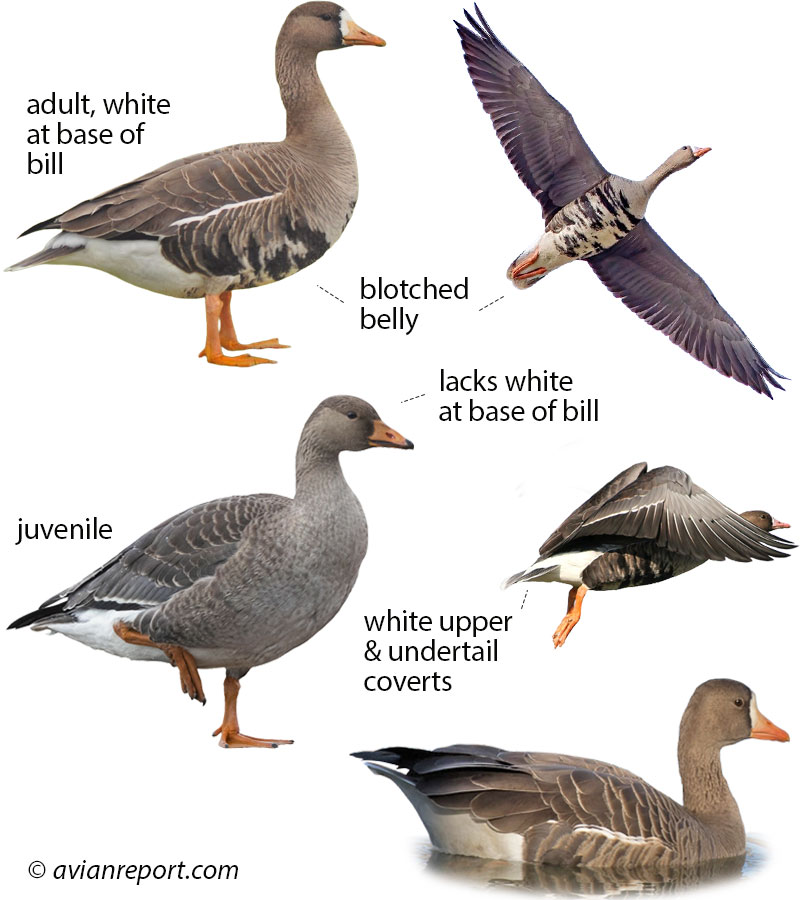
Length: 29 in, Weight: 93 oz, Wingspan: 53 in
Identification: Adults brown, white around the base of pinkish-orange bill, black belly barring, dark tail forms a “U” with upper/undertail coverts. Juveniles lack belly barring/white face feathers.
Compare: Canada Goose neck and head are black. Greater White-fronted Goose has the bill and legs pink-orange.
Behavior: Forages fields/lakes in groups. First to flush when disturbed. Forms long-term pair bonds, stay together year-round.
Flocking: The Greater White-fronted Goose gathers in moderate to large flocks, migrating in less rigid V-formations or undulating lines. Their flight is strong and direct, with deliberate wingbeats, maintaining a consistent speed over long distances.
Habitat: Tundra wetlands, rivers, ponds, sedge meadows, tidal mudflats, agricultural fields, lakes, marshes.
Range: Breeds tundra. Migrates/winters mainly west of Mississippi, California, Texas, Louisiana.
Status and Movements: The Greater White-fronted Goose is a rare winter visitor and transient in Florida. Individuals are occasionally sighted from late fall through early spring, far south of their typical wintering grounds.
Diet: Sedges, grasses, berries, plant tubers (summer). Seeds, grain, grasses (winter).
Nest: Scrape in ground, densely covered by grass/sedge/dwarf shrubs near water/upland tundra. Lined with plant material/down.
Breeding: Egg laying: late May-early Jul | Clutch: 1-8 eggs | Broods: 1 brood | Eggs: White to tan, stained | Incubation: 22-27 days.
Lifespan: At least 25 years, 6 months.
Population: Estimated at 2.1 million individuals.
SWANS OF FLORIDA
Swans are the largest species of waterfowl, easily distinguished from both ducks and geese by their truly massive size, pure white plumage, and exceptionally long necks. They are perhaps the most elegant of all water birds, known for their signature “S” curve of their necks when swimming. Unlike native swans, which are migratory, the introduced Mute Swan is primarily an ornamental species, often found on private and public ponds throughout Florida.
Mute Swan (Cygnus olor)

Length: 55 in, Weight: 349 oz, Wingspan: 88 in
Identification: Entirely white plumage. Orange bill with a black base/knob (knob swells in breeding male). Neck usually curved into an S. Juveniles dusky gray-brown.
Compare: Tundra Swans are smaller than Mute Swans with a black (not orange) bill. They often hold their neck straighter than Mute Swans.
Behavior: Swims with wings slightly raised. Feeds grazing underwater vegetation, raking bottom with feet. Extremely aggressive, attacks intruders.
Flocking: The Mute Swan often flies in pairs or small family groups, sometimes forming larger winter flocks. Their powerful, direct flight features slow, deep wingbeats producing a characteristic humming sound, moving steadily in loose lines.
Habitat: Urban lakes, farm ponds, rivers, estuaries, bogs, creeks, streams, embayments.
Range: Nonnative. Established in the Northeast, Midatlantic, Great Lakes, Pacific Northwest US. The Mute Swan is widespread across these areas.
Status and Movements: The Mute Swan is an introduced, non-native resident in Florida, present year-round in localized populations, primarily on urban ponds. Unlike native waterfowl, this large swan does not migrate, remaining a permanent fixture where established.
Diet: Aquatic vegetation (eelgrass, pondweeds, algae, flowering grasses, grains), frogs, tadpoles, fish, snails, mollusks, insects.
Nest: Large platform of vegetation (twigs, reeds, grasses). Built on peninsula/shoreline/island. Lined with grass/down.
Breeding: Egg laying: late Mar-early May | Clutch: 2-5 eggs | Broods: 1 brood | Eggs: Blue-green (changes to white/chalky) | Incubation: 34-41 days
Lifespan: At least 26 years, 9 months.
Population: Global population estimated at 400,000 individuals.
The Urban Mix: Feral and Domestic Waterfowl of Florida
In Florida’s parks, retention ponds, and urban lakes, birders and casual observers often encounter waterfowl that do not fit the description of wild, native species. This group, labeled Feral and Domestic Waterfowl of Florida, consists of birds that have either escaped captivity, been intentionally released, or are descendants of those birds.
Identification Challenges
The presence of domestic stock, particularly the Mallard and the non-native Muscovy Duck, leads to two major identification hurdles:
- Variable Plumage: Domestic birds, descended from wild stock, have been bred for varied colors (white, black, crested, etc.). These individuals often show exaggerated features or color patterns never found in wild populations.
- Hybridization: Domestic birds readily interbreed with wild counterparts and with other domestic strains, resulting in a large number of hybrids. These birds often exhibit a confusing mix of physical traits that makes tracing their parent species virtually impossible.

Feral Muscovy (Cairina moschata): Large, long-bodied duck with a carunculated (red, warty) face mask. Plumage is highly variable (black, white, piebald) but retains the large white wing patch.
Pekin Duck (Domestic Mallard): Large and heavy, entirely white body; bright yellow-orange bill and legs.
Rouen Duck (Domestic Mallard): Very large and heavy version of the Mallard; often has the same rich brown and green plumage.
Hybrid Mallards: Exhibits a confusing mix of traits. Look for: Patches of pure white on a normally-colored duck; a green head with a speckled or streaked breast; or odd bill/leg colors.
Crested Duck (Domestic Mallard): Any color (often white, piebald, or mottled) but defined by a distinct puff of feathers on the top of the head.
Chinese Goose (Anser cygnoides domesticus): Recognized by the distinctive large, raised knob or ‘knob-bill’ at the base of the forehead, just above the bill. Usually white or brown/gray, with a long, slender neck.
Graylag (Barnyard) Goose (Anser anser): Large, bulky gray or white goose with thick neck, stout legs, and a prominent orange or pink bill. Often appears very heavy-bodied and flightless.
Egyptian Goose (Alopochen aegyptiaca): Large, goose-like bird with pink legs/bill and a conspicuous dark brown eye patch (goggles). The body is beige, gray, and brown with a unique white-and-black wing pattern visible in flight.
The most confusing identification issues in Florida’s urban environments stem from non-native species like the Feral Muscovy Duck and the various domestic Mallard hybrids. The image above features the nine most common non-native species you may encounter in Florida’s city parks, retention ponds, and suburban waterways. These non-native ducks and geese are the primary cause of ID confusion in the Sunshine State.
For a complete North American guide covering the lineage, identification keys of these confusing domestic and invasive species, please consult our in-depth article: Beyond the Mallard: A North American Guide to Urban Ducks, Geese, and Hybrids.
Florida Waterfowl Hotspots: Top 5 Locations for Viewing
Florida’s wetlands shape the state’s landscape and provide essential habitats for waterfowl. From vast marshes to dense swamps and coastal mangroves, each ecosystem supports unique species and offers outstanding birdwatching opportunities.
Major Florida Wetland Ecosystems
The top five locations in Florida known for significant waterfowl concentrations and species diversity, particularly during the winter migration, are:
Merritt Island National Wildlife Refuge (NWR): Located on the Atlantic coast near Titusville, this is arguably the premier spot for sheer numbers and diversity. Its mosaic of brackish lagoons and freshwater impoundments attracts huge concentrations of Northern Pintail, Green-winged Teal, American Wigeon, and Redhead.
Lake Okeechobee: As the state’s largest lake, it acts as a massive wintering ground and year-round residence. The large, open water areas attract huge numbers of diving ducks (like Scaup and Canvasback), while the shallow marshy edges are key habitats for Mottled Ducks and Whistling-Ducks.
St. Marks National Wildlife Refuge (NWR): Situated on the Panhandle’s Gulf Coast, this refuge features extensive coastal marshes and tidal flats. It is a critical stopover and wintering site, particularly good for Gadwall, Northern Pintail, and various sea ducks and mergansers in the adjacent bay.
Lake Apopka Restoration Area: The successful restoration of this large central Florida lake has created enormous new wetland habitats. The resulting shallow, vegetated areas now host spectacular concentrations of Northern Shoveler, Teals (both Blue and Green-winged), and large mixed flocks of dabblers.
Everglades National Park (and surrounding wetlands): While the density may be spread out, this vast area is critical for year-round residents and unique tropical species. It is the best place to find high numbers of Fulvous Whistling-Ducks and Black-bellied Whistling-Ducks, as well as resident Wood Ducks and the Florida-endemic Mottled Duck.
Threats and Conservation Status of Florida Waterfowl
The conservation status of Florida waterfowl varies widely, with some species experiencing stable or increasing populations, while others face steep declines and require significant management intervention. Conservation assessments, such as those provided by Partners in Flight, often utilize the Continental Concern Score (typically rated out of 20), where lower scores indicate a species of lower conservation concern.
Species of High Conservation Concern and Decline in Florida
Several waterfowl species are facing significant population declines, resulting in high conservation rankings:
- Red Alert Tipping Point Species: The 2025 State of the Birds report lists the Mottled Duck as Red Alert Tipping Point species, signifying that it has lost more than 50% of their population in the past 50 years, maintain perilously low numbers, and exhibit steep declining trends. The Mottled Duck experienced a cumulative decline of 72% between 1966 and 2023.
Key Threats to Waterfowl Populations
Conservation efforts focus on mitigating several major threats spanning habitat loss, pollution, biological pressures, and climate change:
1. Habitat Loss and Degradation
Wetland loss and degradation due to human development, agricultural practices, and resource extraction represent a widespread challenge.
- Wetland Drainage and Conversion: For the Mottled Duck, wetland drainage in Florida pose serious conservation issues.
2. Biological and Ecological Threats
- Hybridization: Hybridization with the ubiquitous Mallard poses a threat to related species, most notably the Mottled Duck. This problem is particularly pronounced in Florida, where hybridization has produced “Muddled Ducks,” and is estimated to affect 10% of the Mottled Duck population there. Mallards may also contribute to the decline of the American Black Duck by displacing these shyer ducks from habitats and interbreeding with them.
Read more about the Conservation Status of North American Ducks, Geese, and Swans.
Conclusion:
This guide provide the tools to navigate the diverse world of Florida waterfowl. It provides the foundation for confident identification, covering native, migrants, and addressing confusing urban species. We encourage you to use the information provided here as you explore the state.
Photo Credits:
The photographic material used in this guide was made available on various websites. Many thanks to Andrew Morffew, Mark Mochell, Elizabeth Milsom, Emily Chen, Dennis Church, Wendy Miller, Ken Slade, John Benson, Mick Thompson, Steve Guttman, Nicole Beaulac, Andy Reago, Chrissy McLaren, Garry C., Shawn Taylor, Steve Kersting, Gary Leaven, Vicky DeLoach, Don Hoechlin, Tom Murray, Kevin Krebs, Deborah Freeman, Kenneth Cole-Schneider, Doug Greenberg, Ian Preston, Brian Garrett, John Strung, Becky Matsubara, Judy Gallagher, Bob Jensen, Veit, Sand Diego Zoo, David Inman, Dan Mooney, Ian Preston, Lloyd Davis, Denis Fournier, Gregory Heaton, Greg Lavaty, Dona Hilkey, Alain Doyle, Aaron Maizlish, Ashley Tubs, Richard George, Ethan Gosnell, Nick, , Steve Valasek, Mitch Walters, , and Julio Mulero.
Voices:
Most recordings were obtain from: (Xeno-canto https://xeno-canto.org/)
References and Sources:
- Allaboutbirds.org
- eBird. (https://ebird.org/)
- Birds of the World: https://birdsoftheworld.org/bow/home
- Gill, Frank B., 1994. Ornithology – 2nd Edition, W. H. Freeman and Company.
- Sibley, David, 2000, The Sibley Guide to Birds. Alfred A. Knopf, Publisher.
- Species Longevity Data: United States Geological Survey (https://www.usgs.gov/)
- The Sibley Guide to Bird Life and Behavior, 2001. Chris Elphick, John Dunning, and David Sibley (eds). Alfred A. Knopf, New York.
Author: